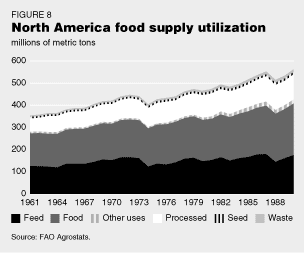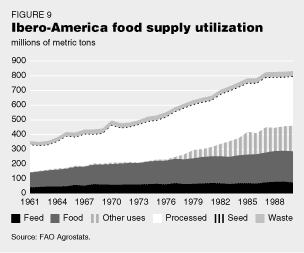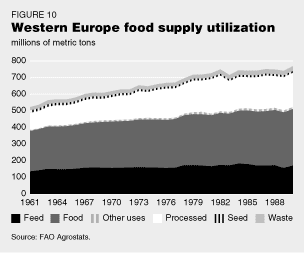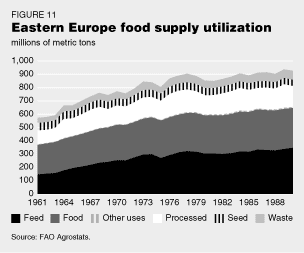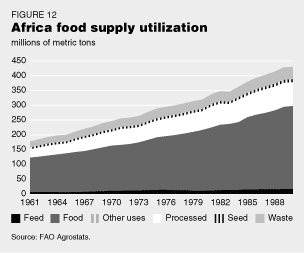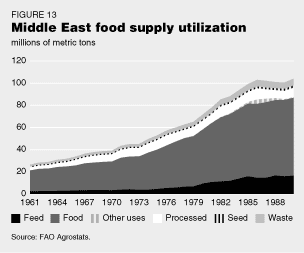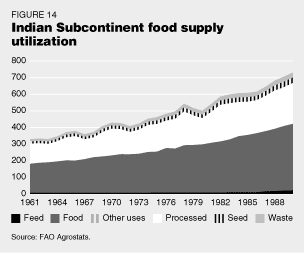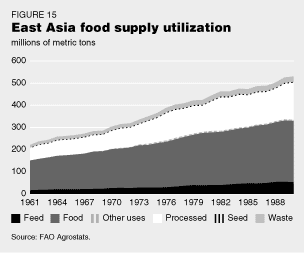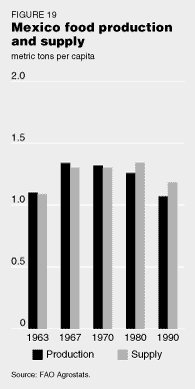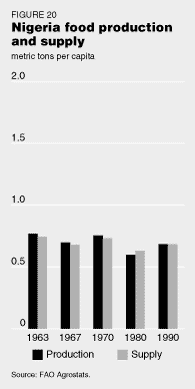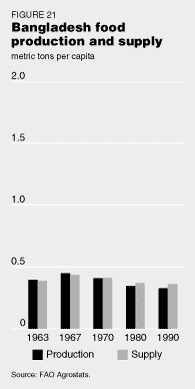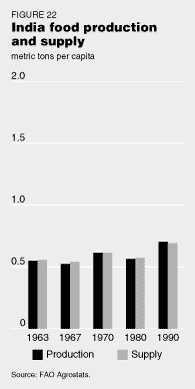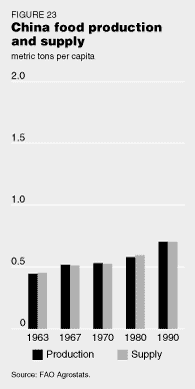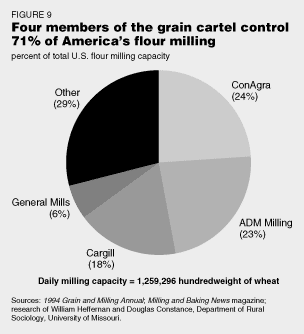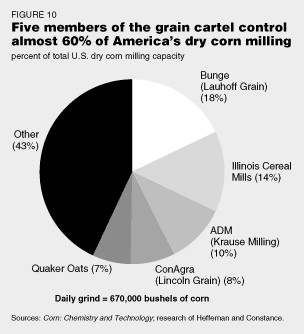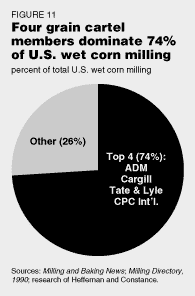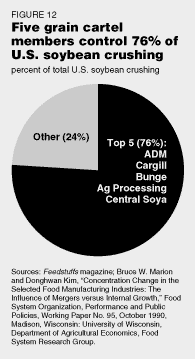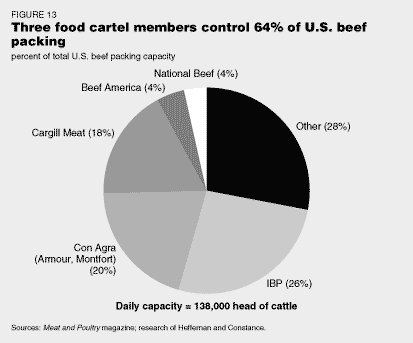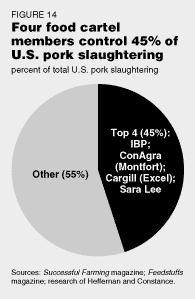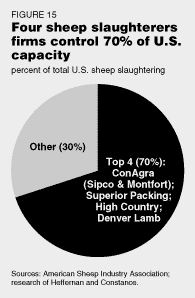
from
LaRouchePub Website
Contents
-
Introduction
-
World Food Shortage Follows
Imposed Import-Dependency
-
Kissinger's 1974 Plan for Food
Control Genocide
-
The Windsors' Global Food Cartel -
Instrument for Starvation
-
Control by the Food Cartel
Companies - Profiles and Histories
-
The Cartel 'Experts' Decide Who
Eats
Introduction
by Marcia Merry Baker
This article appeared in the December
8, 1995 issue of Executive Intelligence Review
This week's cover photo, showing corn piled on the ground, out in the open,
near Minnesota grain elevators, is representative of the disintegration of
the food supply system the world over. While the U.S. Midwest corn and
soybean harvests were coming in this fall, the U.S. rail freight system
broke down.
After years of financial mergers, asset stripping, and rail
track removal, such companies as Union Pacific, which are considered to be
financial "successes," failed miserably on the economic front, and could not
even supply engines to move the grain cars.
Millions of bushels of grain are
sitting, rotting on the ground.
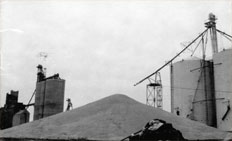
This grain transport breakdown is but one recent example of breakdown in the
food supply in what is considered the most food-secure nation in the world,
and illustrates the fact that "natural disasters" - bad weather, floods,
droughts - are not the cause of the world's food crises.
These examples, and
equivalent situations all around the world, are "unnatural" disasters,
caused by years of takedown of agriculture infrastructure under wrong
policies and assumptions, in particular, serving the interests of private
financial and commodities control circles, centered mostly in London.
The worldwide food crisis is measurable in the decline of grains, of all
types, produced per capita yearly. To provide every person with a daily diet
of their preference, with sufficient calories and nutrients, would require
well over 3 billion tons of grain produced annually. But as of around 1990,
less than 1.9 billion tons were being produced yearly, and since then, world
annual production has declined.
An estimated 800 million people are suffering from some degree of
malnutrition. Besides the nearly continent-wide food supply crisis in Africa,
there are other locations, such as Russia and former Soviet bloc nations,
plunged into crisis. Even under the Soviet command economy, Russia's annual
grain production averaged 100 million tons.
But output has fallen each year
since 1991, to only around 65 million tons this year.
No paradox
What does the international community say? Officially, the United Nations
Food and Agriculture Organization (FAO) and sister U.N. agencies
- the
World
Bank, the
International Monetary Fund (IMF), the
General Agreement on
Tariffs and Trade (GATT), and the World Trade Organization (WTO)
- blame
hunger on "poverty."
The FAO gala conference in Quebec City in October, for the FAO's 50th
anniversary, celebrated the fact that world tonnages of food have increased
over five decades, but lamented that 800 million people don't have enough to
eat - a "paradox," according to the conference speakers. But most of the 100
or more agriculture ministers present knew better.
The last 25-30 years have seen a consistent decline of agriculture output
potential in almost all countries. Necessary ratios of infrastructure
(water, transport, electricity) and inputs (chemicals, mechanization,
quality seeds and stock) have fallen, to the point where output per capita
is sharply declining.
At mid-century, after World War II, there were mobilizations to improve
agriculture output potential on every continent.
-
In western Europe, the Common Agriculture Policy (CAP) of the European
Community saw spectacular rises in agriculture productivity.
-
In Africa, the wave of newly independent nations, such as Sudan (1956), made
technology-based agriculture the keystone of national development plans. The
"Atoms for Peace" movement backed such designs as the continental
electrification of Africa, and the provision of nuclear-power-based energy
grids in Egypt, Iran, and other countries.
-
In North America, plans were drawn up for the
North American Water and Power
Alliance (Nawapa), which would divert river runoff from flowing into the
Arctic Ocean, southward. The Mexico College of Engineers produced plans for
sister hydraulic projects.
-
In Eurasia, blasting was started on Siberian water diversion projects to
channel flow southward from the Ob and Irtysh watersheds, to relieve the
endangered Aral Sea Basin.
-
Development of the Mekong River in Southeast Asia, and improvements in the
Indian subcontinent, were outlined.
But by 1975, most of these projects were shelved. In the eyes of today's "countercultured"
generation, they have receded into the mists of science fiction, if they've
heard of these projects at all.
Over the 1970s, the shift was made to "post-industrial" policies, casino
economics (speculation, derivatives), and free trade demands, enforced by
the IMF Bretton Woods system. And now that financial system itself is in the
process of blowout. The food crisis is the evidence.
Dozens of nations, once self-sufficient in many food staples, have been
forced into food import dependency over the past 30 years. And now, neither
the food stocks, nor the financing, exists for their food supplies. The GATT
launched the "Uruguay Round" for free trade in 1986, under the slogan, "One
World, One Market," which culminated in the creation in 1995 of the World
Trade Organization. But the cupboard of the "World Market" is bare.
Nevertheless, in 1996, the U.N. plans another World Food Summit, on the
theme of "food security," while millions more people go hungry.
Behind the scenes, the private financial interests served by the U.N., IMF,
and other Bretton Woods agencies, are making sweeping moves to acquire food
stocks for hoarding, and to take controlling positions in food commodities
production, processing, and shipping.
This is the last phase of an era of food-as-a-weapon politics, officially
ushered in in 1974, when then-U.S. Secretary of State Henry Kissinger (now
Sir Henry KCMG) gave the keynote speech at the Rome World Food Conference,
the predecessor to the 1996 Food Summit.
In 1974, Kissinger publicly talked
of food security, while privately he worked to use food control as a weapon
against a target list of nations.
Name the names
In this Special Report, we have assembled the documentation required to
understand the crisis situation in depth, in order to intervene, and reverse
it.
We provide:
-
the statistical overview of the past 30 years of forcing food import
dependency on nations
-
the record of Henry Kissinger and the
use of food control as a weapon
-
the names of the companies and individuals who make up the financial and
commodities cartels controlling food supply lines
These reviews are not the usual representation of today's food crisis. The
"common-sense" reasons for food shortages that you usually hear - bad weather,
backwardness, civil strife, etc. - are all wrong.
Worse, the "authorities" on food and agriculture who are usually presented
by the media, will tell you specific lies that have been pre-approved for
public consumption by the financial and commodities cartel interests that
created and continue to back such bogus authorities. For example, Lester Brown, of
Worldwatch Institute, who spoke at the U.N. FAO 50th anniversary,
is constantly in the media, charging that the world's population has
outstripped the world's resources base, and demanding that population be cut
because it cannot be fed.
We supply the pedigree of Lester Brown, and other
hired hands of the food cartels, so you know where the lies are coming from.
Emergency measures required
The information below (with more to come in follow-up reports in 1996), has
been assembled in order to spur the mobilization for emergency financial and
economic measures to deal with food shortages and the overall physical
economic breakdown.
Several rear-guard actions were launched in 1995. They are well motivated,
but they will not do the job. A bill is before Congress, sponsored by Sen.
Tom Daschle (D-S.D.) and others, to create a special commission to
investigate control over the U.S. food supply by a "concentration" of
processors.
An Agriculture Department investigation is under way of the
monopolistic actions of IBP, the Nebraska-based, London-associated, largest
meat processor in the world.
The Justice Department Anti-Trust Division has
grand juries working on international price-fixing charges against the
London-associated cartel companies,
But dealing with the famine-scale food crisis, and financial disintegration,
requires more than prosecution of isolated acts of wrongdoing, or mere
"bigness."
Read on, to find out what every citizen needs to know to do the
right thing.
Back to Contents
World Food Shortages Crisis Follows Decades
of Imposed Import-Dependency
by John Hoefle and Marcia Merry Baker
This article appeared as part of a
feature in the December 8, 1995 issue of Executive Intelligence Review.
The current world food crisis is usually portrayed as a grains shortages
crisis. Annual world grains output (grains of all kinds, including wheat,
corn, barley, millet, rice, etc.) has stagnated, or declined, to around
1,900 million tons or less for the past five years (see Figure 1), at a time
when, based on 1980s population figures, over 3,000 million tons of grains
produced annually is required to ensure that dietary needs are met globally.
There is something radically wrong when the total of the world's grains
harvested stagnates, or drops.
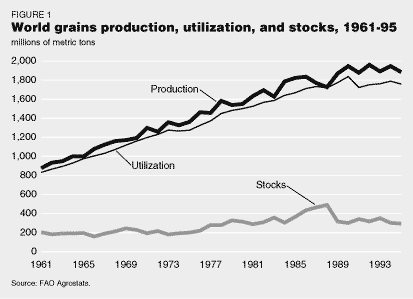
The picture is even worse on a per-capita basis (see Figure 2).
For everyone
to have decent daily rations, whatever the relative percentages of cereals,
animal proteins, and the other food groups that anyone's dietary preferences
dictate, there needs to be well over 14 bushels of grains available in the
world food chain per person, on average. But millions are without even their
daily bread.
For millions, there are fewer than 10 bushels of grain per
capita in the food chain.
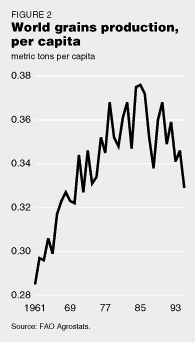
Production is below 1980s level of use
An indication of just how low annual grains output is, is that production is
below the average utilization level of the 1980s (see Figure 1). Today's
global grains output of about 1,900 million tons a year, means that annual
grains output is dropping below the level of yearly global grains
utilization (for direct human consumption, livestock feed, seed, and all
other uses) which existed for several years in the 1980s (see EIR, Sept. 15,
1995).
This means that more and more people don't have the food they need.
And whatever stocks of grains were on hand in recent years as carryover from
harvest to harvest or reserves for emergencies, have been, relatively
speaking, wiped out. Only in exceptional places, such as India, are there,
at present, significant reserves.
Today, world grains carryover stocks are at the same absolute levels they
were 20 years ago. Stocks have dropped from 460-490 million metric tons in
the late 1980s, down to less than 250 million tons projected for year-end
1995 - the level of stocks in 1969.
The only reason that there are stocks reported at all is that consumption
itself (for livestock feed, cereals consumption, etc.) is declining. This
has been apparent for the past few years.
If this grains gap is obvious on the crude scale of world tonnage
statistics, it is even more manifest at the local level, where there are
millions of undernourished people at points of need around the globe.
Thus, the situation in grains production and shortages is a good marker of
the overall food crisis. Dozens of countries, with millions of people, have
gone from national self-sufficiency in basic grains, to dependency on
imports or donated cereals aid. And now the grain isn't there.
Figure 3
shows the decline in annual global food aid in grains from the World Food
Program over the past 10 years, from a peak of 15 million tons, down to
little more than 7 million tons this year.
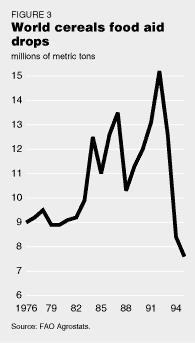
Decline in national food self-sufficiency
The decline in national food self-sufficiency for certain food items is
shown in Table 1 for 15 selected countries at two points in time, 1963 and
1990.
The countries analyzed include the 13 nations specified in National
Security Study Memorandum 200 (NSSM-200), prepared under
Henry Kissinger in
1974 (see below article), plus the former U.S.S.R. and China (see Figure 4).
All
15 nations are hereafter called the "targeted" group.
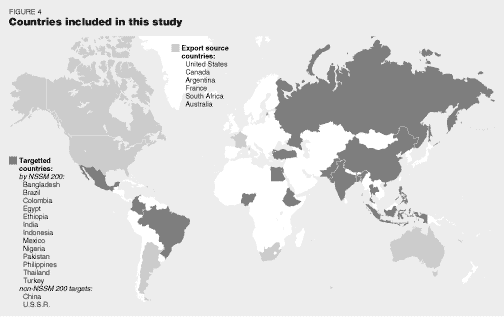
By 1990, there were significant drops in food self-sufficiency over the
prior 27-year period.
Look first at cereals (Table 1, column one). In 1963,
Mexico was 100% self-sufficient in grains output; it was a grains-exporting
nation. As of 1990, Mexico was only 79% self-sufficient, i.e., a grains
importing nation. The situation is even worse today.
Elsewhere in the Western Hemisphere, Brazil was about 90% self-sufficient in
cereals in 1963, but dropped to 76% self-sufficient in 1990. Colombia
remained about the same, staying at only 86-87% self-sufficient. Other
nations in Ibero-America (not shown), saw drastic declines in basic grains
self-sufficiency.
For example, Haiti, in 1970, was close to 95%
self-sufficient; but, as of 1990, self-sufficiency had dropped down to 45%.
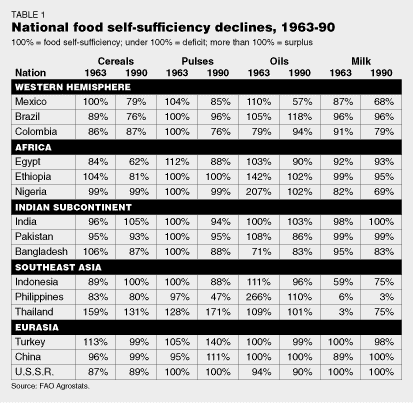
In Africa, Egypt was 84% self-sufficient in cereals production in 1963, and
only 62% self-sufficient in 1990.
Ethiopia was over 100% self-sufficient in
grains supply in 1963, and dropped down to 81% self-sufficient in 1990.
Nigeria remained at 99% self-sufficiency in grains the entire period, but,
as will be shown below, grains declined markedly as a component of the daily
diet. Other locations in Africa saw drastic declines in grain
self-sufficiency.
For example, Algeria was 76% self-sufficient in grains in
1970; in 1990, Algeria was only 44% self-sufficient.
On the Asian subcontinent, the cereals self-sufficiency ratios show no
declines for India, which went from 96% to 105% over 1963 to 1990, and
Pakistan, which stayed at the 93-95% level.
India has managed to stockpile
as much as 40 million tons of grains as of year-end 1995, and may undertake
certain exports. However, Bangladesh has gone from 106% grains
self-sufficiency in 1963, down to 87%, and is subject to wide swings from
year to year in grains supplies.
In Southeast Asia, wide annual swings in staple grains are also now common.
-
In 1963, Indonesia was 89% self-sufficient in cereals; in 1990, it was 100%
self-sufficient. But in several years since then, it has fallen back to rely
on imports.
-
Similarly, the Philippines stayed at 80-83% self-sufficiency
levels for 1963 and 1990, but in recent years has seen growing dependency
because of shortfalls in rice.
-
Thailand, from which the cartel trading
companies export many kinds of commodities (corn, livestock feed, meat,
processed foods, etc.), was 159% self-sufficient in cereals in 1963, and
131% in 1990.
-
In Western Asia, Turkey was 113% self-sufficient in grains in 1963, and was
still 99% self-sufficient in 1990.
-
China, throughout the period, was 95-100% self-sufficient in grains, with
changes from year to year from being a net importer or exporter.
-
The Soviet Union, likewise, remained grains import-dependent throughout the
1963-90 period, showing about 87-89% cereals self-sufficiency.
Grains supply is misleading
However, restricting the food crisis to the metric of the grains supply
situation is a deliberately misleading practice (see below article) which leaves
out the essentials of the crisis that has come, over the past 30 years, to
extend throughout the entire national agricultural sectors and food supply
systems.
Many of these 15 nations also became supply-short and import-dependent,
i.e., experienced food self-sufficiency declines, for other basics in their
diet. Also shown in Table 1 are pulses (peas, beans), oils (tropical, olive,
corn, or other vegetable fats), and milk (including dairy products other
than butter).
Note the sharp declines in food self-sufficiency in non-grains diet staples.
For example, for pulses, Mexico dropped in self-sufficiency from 104% in
1963 down to 85% in 1990; in oils, from 110% down to 57%; and in milk, from
87% self-sufficiency down to 68%. Brazil became a source of soybean oil
exports over this period - for the cartel companies.
Egypt's self-sufficiency in pulses and oils declined. Nigeria, which had
been a source of cartel tropical oils exports, experienced a decline as
well. In 1963, Nigeria was 207% self-sufficient in oils, and in 1990, only
102% self-sufficient.
On the Indian Subcontinent of Asia, note the declines in Bangladesh's
self-sufficiency in pulses and milk between 1963 and 1990.
In Southeast Asia, various patterns are apparent. The Philippines dropped in
self-sufficiency from 97% to 47% in pulses, and also declined as a source of
tropical oils commodities for cartel export.
China remained relatively the same in self-sufficiency for these staples.
And, likewise, Turkey and the former U.S.S.R. did not experience radical
changes.
Overall, the increase in food import-dependency during 1963-90, although
hailed by United Nations officials and the commodities cartel-backed
"experts" and others as reflecting geographical "competitive advantages,"
"consumers' rights to access world markets," or other such euphemisms, in
fact, reflects the impact of successive years of International Monetary Fund
(IMF) conditionalities and Bretton Woods policies, in which developing
nations were denied the means to build up needed agricultural infrastructure
(energy, water, transport, handling, storage, processing) to provide for
national food supplies.
Over this period, nutrition levels have dropped in most countries, as
nations were increasingly forced into food import-dependency. At the same
time, cartel commodities companies made a killing in profits off of their
domination over both the export-import trade, and domestic food processing
and distribution.
The deficits in food supplies shown in the food self-sufficiency ratios in
Table 1, are not measured against what people ought to be eating for a
decent diet, but rather, merely show what part of their diet, however
inadequate, is imported. Look at what this means in the case of Mexico.
Figures 5 and 6 show the drop in cereals self-sufficiency in Mexico from
1970 to 1994, and the drop in per-capita cereals consumption (whether for
direct consumption, or via the animal protein cycle) over the same time
period. It is estimated that up to one-third of the Mexican population is
now suffering some form of malnutrition.
In the spring of 1995, the federal
government declared 12 official hunger zones in the republic.
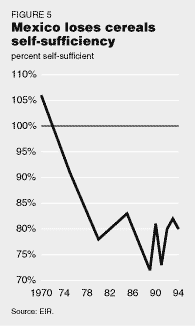
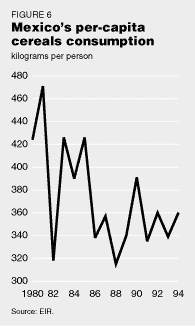
Start from food use profiles
To provide an overview of the world food crisis, apart from any one food
commodity, one country, one crop season or harvest, we here publish a series
of figures based on the U.N. Food and Agriculture Organization agricultural
database.
The figures take 14 basic food groups common to most countries'
diets, and their tonnages in terms of annual supplies, over the time period
approximately 1960-90, in terms of several ratios, including production
compared to "supply" (the quantity available from production, plus the net
adjustment of stocks, plus the net adjustment for imports and exports), and
production and supply per capita.
The 14 food groups are listed in Table 2.
For purposes of comparison, we
have not listed seafoods.
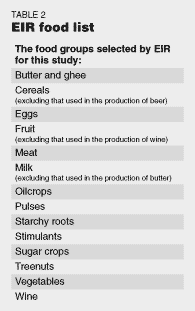
We begin by looking at the world profile of annual utilization of the total
tonnages of these 14 food groups, and major geographic regions.
We then
proceed to look at the food supply and import-dependency ratios on a
per-capita and national basis for two selected groups of nations, as
explained below.
Figure 7 shows the total tonnages of annual use of the 14 selected food
groups, from 1961 to 1990, in terms of how much tonnage goes for feed (food
for livestock), food (direct human consumption, the largest tonnage),
"other" uses (ranging from using biomass for fuel, to plastics), processing
(intermediate stages of food preparation), seed, and waste.
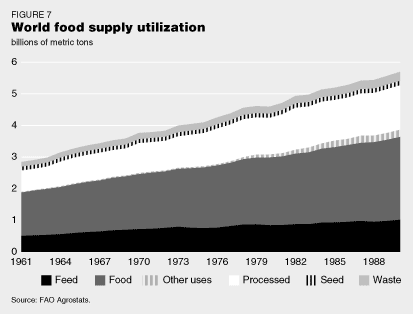
The increase from less than 3 billion tons of basic food commodities in the
food supply to close to 6 billion tons over the roughly 30-year period,
comes out to a change per capita of from about 2,050 pounds of food
commodities per person in 1963, to about 2,200 pounds per person in 1990.
However, on a regional and national scale, the volumes and ratios differ
greatly.
The next series of figures (Figures 8 through 15) show the food supply
utilization profiles for major geographic regions - the Western Hemisphere,
western and eastern Europe, Africa, the Middle East, the Indian
Subcontinent, and East Asia.
Some of the most striking differences, even at this gross level of
aggregation, are noted, taking each of the uses for food commodities in
order shown on the graphics.
-
Feed for livestock. North America and Europe show relatively the largest
volume of agricultural commodities going into livestock feed. In contrast,
very little goes for livestock feed in Africa or in the Indian subcontinent.
-
Food. Africa shows the highest relative share of food going for direct human
consumption. This reflects the extensive subsistence production of cassava
and various grains, that do not go through even intermediate processing.
-
Other uses. Extensive use of agricultural commodities for non-food or feed
uses show up dramatically in the Americas. Beginning in the 1970s, the use
of sugar cane and other biomass for alcohol fuel, e.g., "gasohol," was
initiated on a large scale in Brazil. In the United States, beginning in the
late 1970s and increasingly up to the present, corn has been processed for
ethanol.
-
Processed. The regions show differences in the degree of intermediate
processing of food commodities, with the least processing being done in
Africa and the Middle East.
-
Seed. The necessary volumes of seed for the annual crops cycles are shown
for each geographic region.
-
Waste. Relatively the largest volume of food commodities wasted shows up in
Africa and in eastern Europe. What this reflects is the absence of
protection - storage facilities, pesticides and other chemicals,
refrigeration, and transportation. Loss rates to waste add up to 40% in many
tropical regions.
Who eats, and who doesn't?
For a closer look at the food supplies crisis, we focused on two groups of
countries (see Figure 4) for five points in time from 1963 to 1990. There
are the "targeted" nations, the 13 designated in the Kissinger NSSM-200,
plus China and the former U.S.S.R.
In contrast, there are the "export
source" countries:
-
the United States
-
Canada
-
Australia
-
France
-
South
Africa
-
Argentina
These latter six nations together are the origin for
a large percentage of the total tonnages of food products that the
commodities cartels control and use to dominate world trade and food
supplies (see article).
Compare Figure 16 with Figure 17, and you see that, per capita, the levels
of food production and supply are about the same in the "targeted" nations;
but in the "export source" group of nations, production far exceeds supply.
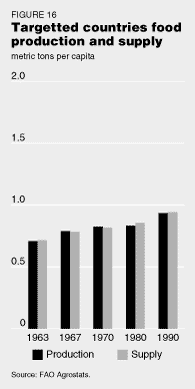
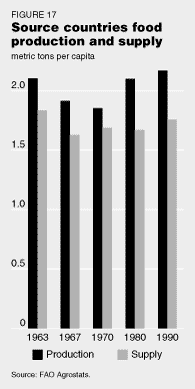
Moreover, the level of production and supply in the
targeted nations is
less than a metric ton per capita per year, whereas in the "export source"
nations, there are about 1.75 tons of food supply per capita per year.
Over 1963-90, there is an increase in the per-capita production and supply
levels in the targeted countries, from 0.7 metric tons in 1963 up to 0.9
tons in 1990, but the targeted nations group never comes close to even the
1963-67 level of supplies per capita in the "export source" nations.
Furthermore, Figure 18 shows the food production per capita in each of the
six "export source" nations. Look at the high tonnages in Australia and
Canada, in particular - the Commonwealth nations used as postwar "granary"
economies for London-interlocked commodities cartels.
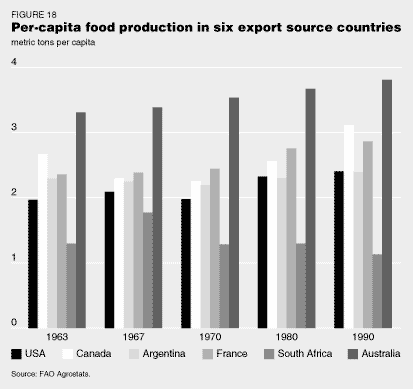
Now look at certain individual nations in the other group, the "targeted"
nations, in terms of levels of production relative to supply (Figures 19 to
23). Shown are Mexico, Nigeria, Bangladesh, India, and China.
In none of
these nations does production or supply come near that of the "export
source" nations.
Diet deteriorates
While Figures 19 to 23 indicate how low the absolute tonnages of food
production and supplies are in the targeted nations, the deterioration in
the composition of the diet can be seen by looking in more detail at the
constituent food groups that make up the diet.
Look, for example, at
Nigeria.
Figure 24 shows the relative percentages of the different food groups that
make up the total annual food utilized in the country, in 1963, and then in
1990. We are looking at production, because it is about equivalent to supply
in Nigeria.
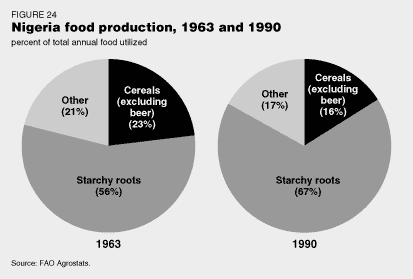
The largest component is starchy roots, about 56% of the diet in 1963.
In
1990, this has gone up to almost 67% of the diet. Mostly, this is cassava,
which, along with a variety of companion foods, is part of West African
cuisines. However, the increased use of cassava from 1963 to 1990 reflects
not a dietary preference, but rather a forced reliance on the root vegetable
as a heavy-bearing crop, on which people can subsist, i.e., it's filling,
but not nutritious.
This monoculture reliance is labeled a "success story" by cartel-affiliated
groups active in promoting cassava in Nigeria and Zaire, such as, for
example, the International Institute of Tropical Agriculture and the
International Food Policy Research Institute.
What is shown as the "other" segment on the Nigeria food charts, is the
total of all 12 other food types. In 1990, this included 5.4% vegetables;
3.5% fruits; 2% peas and beans; 1.6% sugar crops; 1% meats, and even lesser
amounts of the remaining food groups.
For comparison, look at the shares of different food groups in the U.S. diet
in 1967 (Figure 25). This shows supply, not production, because the United
States is a cartel "export source" nation.
The most striking feature of the
U.S. food supply, is the variety and quantity of many different foods.
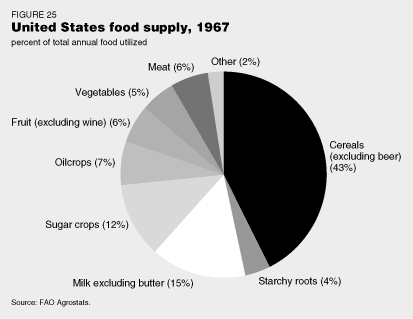
For further comparison, look at the relative shares of food groups in the
food supply in China, in 1963 and in 1990 (Figure 26).
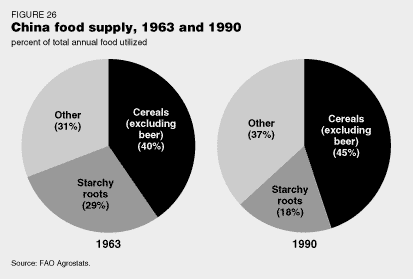
Burden of producing food
These data document the worsening inadequacies in the food supplies of many
nations, from the 1960s to the present. But, producing the food supply,
however inadequate in amount and make-up, nevertheless involves most of the
time and effort of the populations in the "targeted" group of nations.
One measure of the burden of producing the daily diet is the relatively
large percentage of workers engaged in agriculture, as opposed to
manufacturing, construction, and socially necessary tasks such as education,
transport, and other infrastructure.
Figure 27 shows agricultural workers as
a percentage of the total work force, for five time periods, from 1963 to
1990, for the United States and the two economic groups of the study.
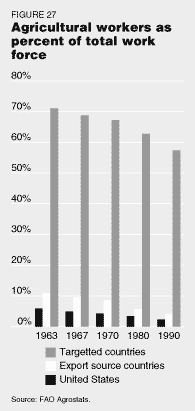
Over 70% of the work force of the "targeted" nations were in the
agricultural sector in 1963; and during the subsequent three-decade period
of increasing world food import-dependency, and poorer diets, this
percentage fell to only about 58%.
Moreover, for most countries, this does
not reflect greater agricultural productivity gains, but rather a
dispossession of farm populations, and their migration into the shanty camps
of urban areas.
In the United States, the percentage of the work force in agriculture
dropped from 5% in 1963 to under 3% by 1990. In the "export source" nations
overall, the percentage of workers in agriculture dropped from 11% in 1963,
down to 4.5% by 1990.
In the next installment of this EIR series on food import-dependency and
free trade, we will show in detail the lack of necessary ratios of inputs
(fertilizers, mechanization, transport, and other infrastructure) that
characterizes the agriculture sectors over the past 30 years.
Back to Contents
Kissinger's 1974 Plan for Food Control
Genocide
by Joseph Brewda
This article appeared as part of a feature
in
the December 8, 1995 issue of
Executive Intelligence Review.
On Dec. 10, 1974, the U.S. National Security Council under Henry Kissinger
completed a classified 200-page study, "National Security Study Memorandum
200: Implications of Worldwide Population Growth for U.S. Security and
Overseas Interests."
The study falsely claimed that population growth in the
so-called Lesser Developed Countries (LDCs) was a grave threat to U.S.
national security. Adopted as official policy in November 1975 by President
Gerald Ford, NSSM 200 outlined a covert plan to reduce population growth in
those countries through birth control, and also, implicitly, war and famine.
Brent Scowcroft, who had by then replaced Kissinger as national security
adviser (the same post Scowcroft was to hold in the Bush administration),
was put in charge of implementing the plan. CIA Director
George Bush was
ordered to assist Scowcroft, as were the secretaries of state, treasury,
defense, and agriculture.
The bogus arguments that Kissinger advanced were not original. One of his
major sources was the Royal Commission on Population, which King George VI
had created in 1944,
"to consider what measures should be taken in the
national interest to influence the future trend of population."
The
commission found that Britain was gravely threatened by population growth in
its colonies, since,
"a populous country has decided advantages over a
sparsely-populated one for industrial production."
The combined effects of
increasing population and industrialization in its colonies, it warned,
"might be decisive in its effects on the prestige and influence of the
West," especially effecting "military strength and security."
NSSM 200 similarly concluded that the United States was threatened by
population growth in the former colonial sector.
It paid special attention
to 13 "key countries" in which the United States had a "special political
and strategic interest":
-
India
-
Bangladesh
-
Pakistan
-
Indonesia
-
Thailand
-
the Philippines
-
Turkey
-
Nigeria
-
Egypt
-
Ethiopia
-
Mexico
-
Brazil
-
Colombia
It claimed that population growth in those states was especially
worrisome, since it would quickly increase their relative political,
economic, and military strength.
For example, Nigeria:
"Already the most populous country on the continent,
with an estimated 55 million people in 1970, Nigeria's population by the end
of this century is projected to number 135 million. This suggests a growing
political and strategic role for Nigeria, at least in Africa."
Or Brazil:
"Brazil clearly dominated the continent demographically."
The study warned
of a "growing power status for Brazil in Latin America and on the world
scene over the next 25 years."
Food as a weapon
There were several measures that Kissinger advocated to deal with this
alleged threat, most prominently, birth control and related
population-reduction programs.
He also warned that "population growth rates
are likely to increase appreciably before they begin to decline," even if
such measures were adopted.
A second measure was curtailing food supplies to targeted states, in part
to force compliance with birth control policies:
"There is also some
established precedent for taking account of family planning performance in
appraisal of assistance requirements by AID [U.S. Agency for International
Development] and consultative groups. Since population growth is a major
determinant of increases in food demand, allocation of scarce PL 480
resources should take account of what steps a country is taking in
population control as well as food production. In these sensitive relations,
however, it is important in style as well as substance to avoid the
appearance of coercion."
"Mandatory programs may be needed and we should be considering these
possibilities now," the document continued, adding, "Would food be
considered an instrument of national power? ... Is the U.S. prepared to
accept food rationing to help people who can't/won't control their
population growth?"
Kissinger also predicted a return of famines that could make exclusive
reliance on birth control programs unnecessary.
"Rapid population growth and
lagging food production in developing countries, together with the sharp
deterioration in the global food situation in 1972 and 1973, have raised
serious concerns about the ability of the world to feed itself adequately
over the next quarter of century and beyond," he reported.
The cause of that coming food deficit was not natural, however, but was a
result of western financial policy:
"Capital investments for irrigation and
infrastructure and the organization requirements for continuous improvements
in agricultural yields may be beyond the financial and administrative
capacity of many LDCs. For some of the areas under heaviest population
pressure, there is little or no prospect for foreign exchange earnings to
cover constantly increasingly imports of food."
"It is questionable," Kissinger gloated, "whether aid donor countries will
be prepared to provide the sort of massive food aid called for by the import
projections on a long-term continuing basis."
Consequently,
"large-scale
famine of a kind not experienced for several decades - a kind the world
thought had been permanently banished," was foreseeable - famine, which has
indeed come to pass.
Back to Contents
Back to A
Ponerological Profile - Henry Kissinger
The Windsors' Global Food Cartel - Instrument
for Starvation
by Richard Freeman
This article appeared as part of a feature in
the December 8, 1995 issue of Executive Intelligence Review.
Ten to twelve pivotal companies, assisted by another three dozen, run the
world's food supply. They are the key components of the Anglo-Dutch-Swiss
food cartel, which is grouped around
Britain's House of Windsor.
Led by the
six leading grain companies,
...the Windsor-led food and raw
materials cartel has complete domination over world cereals and grains
supplies, from wheat to corn and oats, from barley to sorghum and rye.
But
it also controls meat, dairy, edible oils and fats, fruits and vegetables,
sugar, and all forms of spices.
Each year tens of millions die from the most elementary lack of their daily
bread. This is the result of the work of the Windsor-led cartel. And, as the
ongoing financial collapse wipes out bloated speculative financial paper,
the oligarchy has moved into hoarding, increasing its food and raw materials
holdings. It is prepared to apply a tourniquet to food production and export
supplies, not only to poor nations, but to advanced sector nations as well.
The use of food as a weapon can be found at least four millennia ago in
Babylon. Imperial Rome took this tack, as did Venice and various Venetian
offshoots, including the Antwerp-centered, powerful Burgundian duchy, and
the Dutch and British Levant companies, East India companies, and West India
companies.
Today, food warfare is firmly under the control of London, with
the help of subordinate partners in especially Switzerland and Amsterdam.
Today's food companies were created by having had a section of this ancient
set of Mesopotamian-Roman-Venetian-British food networks and infrastructure
carved out for them.
The Windsor-led oligarchy has built up a single, integrated raw materials
cartel, with three divisions - energy, raw materials and minerals, and
increasingly scarce food supplies. Figure 1 represents the situation. At the
top is the House of Windsor and Club of the Isles.
Right below are two of
the principal appurtenances of the House of Windsor:
-
the World Wide Fund for
Nature, headed by the Doge of London, Prince Philip, which leads the world
in orchestration of ethnic conflict and terrorism, such as the
British-created afghansi movement
-
the British intelligence's Hollinger
Corp. of Conrad Black, which is leading the assault to destroy Bill Clinton
and the American Presidency
The firms within each cartel group are listed.
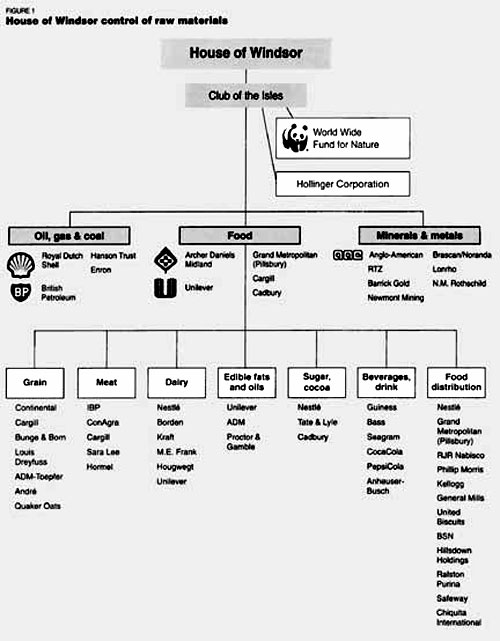
While they maintain the legal
fiction of being different corporate organizations, in reality this is one
interlocking syndicate, with a common purpose and multiple overlapping
boards of directors.
The Windsor-centered oligarchy owns these cartels, and
they are the instruments of power of the oligarchy, accumulated over
centuries, for breaking nations' sovereignty.
The control works as follows: The oligarchy has developed four regions to be
the principal exporters of almost every type of food; the oligarchy has
historically acquired top-down control over the food chain in these regions.
These four regions are:
-
the United States
-
the European Union, particularly
France and Germany
-
the British Commonwealth nations of Australia, Canada,
the Republic of South Africa, and New Zealand
-
Argentina and Brazil in Ibero-America
Through the centuries, the oligarchy has taken control of
these regions' markets, and thus over the world food supply.
These four
regions have a population of, at most, 900 million people, or 15% of the
world's population. The rest of the world, with 85% of the population - 4.7
billion people - is dependent on the food exports from those regions.
British food cartel control intensified after World War II. Regions such as
America had long been seen as important areas in which to increase control,
in order to maintain the cartel's global domination, especially around the
turn of the twentieth century when Minneapolis, under the control of the
Pillsbury and Peavey families, replaced Hungary as the world's major miller
of grain.
But before World War II, the amount of grain that crossed borders,
or oceans, seldom exceeded 30 million tons a year. America's share of that
was usually 10 million tons or less. This was a substantial amount, but
small compared to the levels of trade that would follow. World War II
ravaged the globe, creating mass hunger, especially in Europe and what is
today the Third World.
Under the impetus of American programs such as "Food
for Peace," PL 480, the worldwide trade in grain shot up to 160 million tons
by 1979. Today it is 215 million tons per year. In addition, tens of
millions of tons of other foodstuffs, from meat to dairy, are traded each
year.
It is proper for countries with grain, meat, dairy, and other surpluses to
export them. But the cartel's four exporting regions were given preeminence
in a brutal manner, while much of the rest of the world was thrust into
enforced backwardness. The oligarchy denied these nations seed, fertilizer,
water management, electricity, rail transportation, that is, all the
infrastructural and capital goods inputs needed to turn them into
self-sufficient food producers.
These nations were reduced to the status of
vassals: Either import from the cartel's export regions, or starve.
Meanwhile, the Anglo-Dutch-Swiss food cartel reduced the export regions,
which supposedly enjoy favored status, to a state of servitude as well.
During the last two decades, millions of farmers in the United States,
Europe, Canada, Australia, and Argentina have been wiped out.
For example,
in 1982, the United States still had 600,000 independent hog farmers.
Today,
that number is less than 225,000. The food cartel companies have
concentrated hog production into their own hands. Farmers were paid far
below a parity price, i.e., a price that covers costs of agricultural
production plus a fair profit for investment in future production.
In 1983, Robert Bergland, President Jimmy Carter's agriculture secretary in
1976-80, told an interviewer concerning Cargill, the world's largest grain
company:
"Cargill's view is ... [that] they generally regard the United
States as a grain colony."
Bergland continued,
"When [in 1979] the Russians
invaded Afghanistan and Jimmy Carter asked how much grain the Russians had
bought [from the United States] ... we couldn't tell him because we didn't
know."
But Cargill and the other grain cartel companies knew.
In 1976, when
Cargill, Continental, and other grain cartel companies sold the Russians a
record 12.4 million tons of American and Canadian grain (creating a grain
shortage in the United States), the administration of President Gerald Ford
learned of the sales only after the fact. The grain may have been American
grown, but the Anglo-Dutch-Swiss cartel disposes of it as it pleases.
This article will document, for the first time, the extent of concentration
and control that the British-centered raw materials cartel exercises over
both the international and domestic trade in food. It will look at the food
cartel's international and domestic control of grains, milk, edible oils and
fats, and meat.
The article which follows provides a more detailed profile,
with names and addresses, of the key forces in the cartel's control of the
world's food supply.
Concentration in four food groups
Grains and grain products, milk and dairy products, edible oils and fats,
and meat provide the majority of the intake of calories, as well as proteins
and vitamins, which keeps the human species alive.
Grain and grain products
can be consumed as animal feed (especially corn and oats), and directly for
human consumption, sometimes in grain form (the case of rice or barley), but
often in a milled form, such as in bread and tortillas.
The "Big Six" leading grain cartel companies are:
-
Minneapolis- and
Geneva-based Cargill
-
New York-based Continental
-
Paris-based Louis Dreyfus
-
São Paulo, Brazil- and Netherlands, Antilles-based Bunge and Born
-
Lausanne,
Switzerland-based André
-
Illinois- and Hamburg, Germany-based Archer
Daniels Midland/Töpfer
The first five of the companies are privately owned
and run by billionaire families. They issue no public stock, nor annual
report. They are more secretive than any oil company, bank, or government
intelligence service. Just two of these companies, Cargill and Continental,
control 45-50% of the world's grain trade.
We look at the food cartel's control over each of the four dominant food
groups.
Grains:
Grains, or cereals as they are often called, consist of wheat; the
coarse grains, including corn, barley, oats, sorghum, and rye; and rice.
The Anglo-Dutch-Swiss cartel's control over wheat exports is shown in Figure
2. For the crop year 1994-95, the cartel's four food export regions produced
and traded 88% of the world's wheat exports of 97.2 million metric tons.
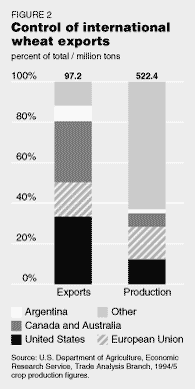
But, the four cartel food export regions, while accounting for 88% of
worldwide wheat exports, accounted for only 39% of all the world's wheat
production of 522.4 million metric tons in the 1994-95 crop year (see Figure
2).
That is, their share of world wheat exports was more than double their
share of world wheat output. This underscores the point that the cartel
built up four regions as the choke points over the world's food supply, even
though these regions, collectively, are not often the largest producers.
Figure 3 shows, for the 1994-95 crop year, the percentages that the cartel's
four food export regions control of the exports of the leading coarse
grains.
They control
-
95% of world annual corn exports, of 69.9 million
metric tons
-
76% of world barley exports, of 14.8 million metric tons
-
97% of world sorghum (milo) exports, of 6 million metric tons
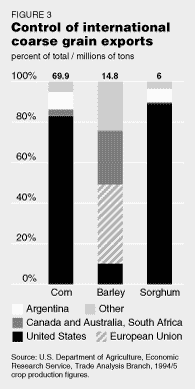
Within these export regions, the cartel's six leading grain companies have,
historically, built up total domination of the external grain markets. While
the cartel's export regions dominate 76-97% of the world's grain trade,
depending on the grain, the cartel's six grain companies also control the
exports of the four regions.
For example, in the 1994-95 crop year, the United States exported 102 of the
world's 215 million metric tons in grain exports, nearly half the total. It
accounted for 33% of world wheat exports, 83% of world corn exports, and 89%
of world sorghum exports, making it the leading exporter in each of these
three markets.
Now, let us turn to the leading grain companies' command of America's grain
export market, with America itself controlling nearly one-half of all world
grain exports. Figure 4 shows that the cartel's Big Six grain trading
companies own and control 95% of America's wheat exports, 95% of its corn
exports, 90% of its oats exports, and 80% of its sorghum exports. A few
smaller companies, almost all in the grain cartel's orbit, control the
remaining market share.
The grain companies' control over the American grain
market is absolute.
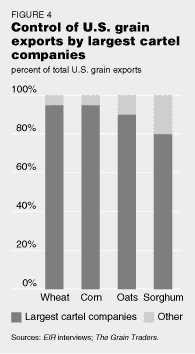
The Big Six grain companies also control 60-70% of France's grain exports.
France is the biggest grain exporter in Europe (the world's second largest
grain exporting region), exporting more grain than the next three largest
European grain exporting nations combined.
Figure 5 shows that the Big Six, along with some affiliated Argentine
companies such as Nidera and ACA, control 67.8%, or two-thirds, of
Argentina's grain exports.
Argentina is the fourth largest grain exporter in
the world.
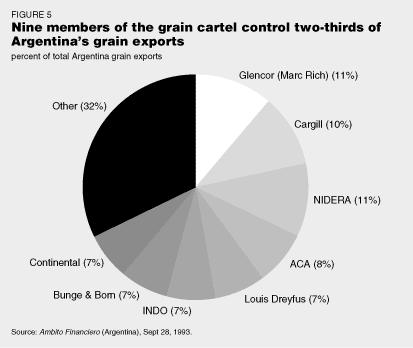
Canada and Australia combined are the world's third largest grain exporting
region, after America and Europe. Although they have their own unique
internal picture, with a modicum of political influence from farmers, both
are British Commonwealth nations, under the thumb of Queen Elizabeth II.
In sum, the Anglo-Dutch-Swiss food cartel dominates 80-90% of the world
grain trade. In fact, however, the control is far greater than the sum of
its parts: The Big Six grain companies are organized as a cartel; they move
grain back and forth from any one of the major, or minor, exporting nations.
Cargill, Continental, Louis Dreyfus et al. own world shipping fleets, and
have long-established sales relationships, financial markets, and commodity
trading exchanges (such as the London-based Baltic Mercantile and Shipping
Exchange) on which grain is traded, which completes their domination.
No
other forces in the world, including governments, are as well organized as
the cartel, and therefore, London's power in this area remains unchallenged.
Milk and Milk Products:
The big exporters of milk and milk products are
three out of the cartel's four basic export regions:
-
the United States
-
the
European Union plus Switzerland (which is not an EU member)
-
the British Commonwealth countries of
New Zealand, in particular, and Australia
In 1994, the cartel's domination of dairy and dairy products was
astonishing.
Figure 6 shows that the cartel's food export regions controlled
-
89% of the world's export of whole milk powder, of 1.08 billion metric tons
-
94% of the world's export trade of 653 million metric tons of butter
-
86% of the world's export trade of 1.11 billion metric tons of cheese
It
also controlled a huge portion of the export of condensed milk.
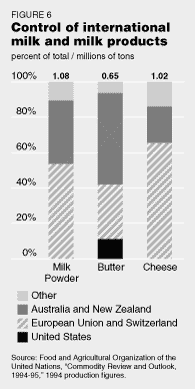
The case of whole milk powder exemplifies the process of the cartel's
control.
Milk is not usually exported in liquid form, except for short
distances over nearby borders; it is usually exported either as whole milk
or skim milk powder, or as condensed milk. When it is exported as whole milk
powder, it is reconstituted upon delivery, usually at the ratio of 10 parts
water to 1 part whole milk powder. Of the world's export of 1.08 billion
metric tons of whole milk powder in 1994, the developing world imported 885
million metric tons, or 82% of the total.
Nestlé Corp., S.A., based in Vevey and
Cham (near Geneva), Switzerland, and
Borden, Inc., based in Columbus, Ohio, are the two largest exporters of
whole milk powder in the world.
Founded in 1867, Nestlé grew significantly
in 1905, when it merged with the Anglo-Swiss Condensed Milk Company, also of
Switzerland.
Nestlé S.A. illustrates the food cartel's global reach:
-
it is
the number-one world trader in whole milk powder and condensed milk
-
the
number-one seller of chocolate, confectionery products, and mineral water
(it owns Perrier)
-
the number-three U.S.-based coffee firm
Its products
include:
-
Nestlé chocolate and candy
-
Libby fruit juice
-
Carnation Condensed
Milk
-
Buitoni spaghetti
-
Contadina tomato paste
-
Hills Brothers and Nescafé
coffees
-
Stouffers' restaurants and frozen foods
-
(It also owns 26% of
the world's biggest cosmetic company, L'Oreal)
All told, it is the biggest
food company in the world. In 1994, there were 13 countries in which Nestlé
had sales of 1 billion Swiss francs or more, including all advanced sector
nations. Its total 1994 sales were SF 56.9 billion, or $45.5 billion. Its
1994 profits were $4.8 billion, bigger than all but a half-dozen companies.
Nestlé chairman Helmut Maucher is on the board of J.P. Morgan, British
intelligence's leading bank in the United States. Its board of directors
serves as a retirement home for the world's central bankers: Fritz Leutwiller, former chairman of the Basel, Switzerland Bank for International
Settlements, the central bank of central banks, is on Nestlé's board, as is
Paul Volcker, who, as chairman of the U.S. Federal Reserve Board in 1979 and
the early 1980s, put the world economy through what was referred to as
"controlled disintegration."
Borden is the second biggest milk powder producer, through its KLIM milk
powder division. It is also one of the world's biggest condensed milk
producers, through its Eagle Brand sweetened condensed milk. In 1995, Borden
was bought by the leveraged buy-out firm of Kohlberg Kravis Roberts, which
is headed by Henry Kravis, who was finance committee co-chairman of George
Bush's 1992 Presidential campaign.
As a result of the 1988 merger of R.JU.
Reynolds and Nabsico, KKR now owns 33% of, and effectively controls, RJR
Nabisco, which produces nine of the top ten cookies and crackers brands sold
in America. KKR also owns a portion of Beatrice Foods, a conglomerate, which
makes KKR one of the top five food companies in the world.
Completing the picture of world control of whole milk powder is Unilever, a
large player in this area as well as the number-one world producer of ice
cream and margarine. Typifying the Anglo-Dutch oligarchy's joint control
over raw materials, Unilever, which is the result of a 1930 merger of a
British and a Dutch firm, has headquarters in London and Amsterdam.
On the
Unilever board is Lord Wright of Richmond, GCMG. From 1986 through 1991, he
was head of Britain's Diplomatic Service and also permanent undersecretary
of state at the British Foreign and Commonwealth Office. Lord Wright is also
a director of Barclay's Bank, which is a major funder of Prince Philip's
World Wide Fund for Nature.
Unilever is an example of how the different corporate entities operate as
part of one interlocked syndicate. The former chairman of Unilever, M.F. Van
den Moven, now sits on the board of the other Anglo-Dutch giant, Royal Dutch
Shell Petroleum, the world's largest marketer of oil and a controlling force
in the energy cartel.
Meat:
The cartel's four major export source regions (the United States; the
European Union; the British Commonwealth countries of New Zealand,
Australia, and Canada; and the Ibero-American nations Argentina and Brazil)
exert enormous dominance over meat exports. As well, a Chinese bloc of
China, Taiwan, and Hong Kong (the last nation a re-exporter) is important in
pork and poultry exports.
Figure 7 shows that for 1994, the cartel's basic food export regions
commanded
-
85% of the world's export of beef and veal of 4.95 million metric
tons
-
when the Chinese market is added in, these regions commanded:
The export of pork and
poultry in China and Taiwan is increasingly run by the food cartel.
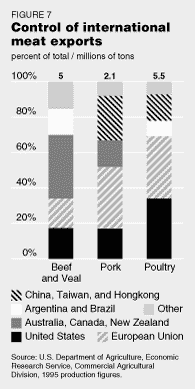
Four of the cartel's biggest companies in beef export are Cargill, Archer
Daniels Midland/Töpfer, ConAgra/Peavey, and Iowa Beef Processors, now called
IBP.
The Dakota City, Nebraska-based IBP exemplifies how the oligarchy
employs its corporate offshoots. Once owned by Armand Hammer's Occidental
Petroleum Co., today 13% of the stock of IBP is owned by FMR Corp., the
holding company for Fidelity Investments, the largest family of mutual funds
in the United States, which is run by the Boston Brahmin oligarchical
families.
FMR is interlocked with other parts of the Windsor cartel
- it is a
large owner of raw material cartel companies, including shares of 5% or more
of Homestake Mining, Coeur D'Alene Mines, and Santa Fe Pacific Gold Corp.,
three of the world's largest gold mining companies.
Through IBP, the food cartel is intervening in the U.S. Presidential
elections, giving heavy backing to the "free enterprise" Presidential
campaign of Sen. Phil Gramm (R-Tex.). On IBP's board of directors is Alec
Courtalis, a Florida real estate magnate who was national finance
co-chairman of the 1992 Bush-Quayle campaign, and is currently chairman of
the futuristic Armand Hammer United World College and finance committee
chairman of the Gramm for President campaign.
In addition, Gramm's wife,
Wendy Gramm, is an IBP board member. From 1988 to 1993, Wendy Gramm chaired
the Commodity Futures Trading Commission, during which time the CFTC rigged
the explosive growth in speculative derivatives instruments.
Edible oils and fats:
The United States, the European Union, and Argentina
and Brazil thoroughly dominate the export market in the soybean and its
by-products, the most basic source of edible oils and fats.
Figure 8
documents that the food cartel export source sectors are the masters of 90%
of the international trade in soybeans, of 32.1 million metric tons per
year; 90% of the international trade in soybean meal, of 31.1 million metric
tons; and, along with British Commonwealth member India, 92% of the 31.1
million metric tons of soybean meal exports.
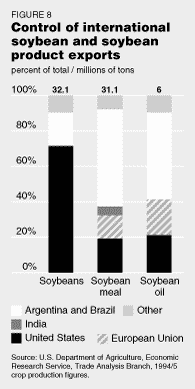
According to spokesmen for the U.S. Department of Agriculture, as well as
private industry, the same six companies that dominate the international
grain trade also dominate the international trade in soybeans and
by-products.
The one additional cartel member company which is influential
in the soybean trade, and which is smaller than the leading six companies,
is S.I. Joseph Co. of Minneapolis, Minnesota.
Burton Joseph, chairman of
this company, is a former national chairman and a leading member of the
Anti-Defamation League of B'nai B'rith. He is a longtime enemy of Lyndon LaRouche.
Feed and seed:
The cartel also controls feed for animals and seed for
planting. British Petroleum, through its Nutrition division, is the largest
feed producer in Europe. Having bought Purina Mills from Ralston Purina
Company, British Petroleum, one of the House of Windsor's key energy
companies, is now the second largest feed producer in America.
Cargill, the
world's largest grain exporter, through its Nutrena Feed division, is also
the biggest producer of animal feed and hybrid seed in the world, while
Continental Grain, through its Wayne Feed division, is one of the biggest
producers of feed and a major force in hybrid seed production.
Domestic markets
The cartel exercises an iron hand over the domestic agricultural economies
of nations, especially those that comprise the four export source regions of
the food cartel. This is exercised through the processing industries: If one
controls the processing industries, one controls domestic trade.
Except for
use as animal feed, corn, wheat, and soybean cannot be eaten in their
unrefined form (excluding sweet corn, which is eaten by humans, but which is
a minuscule percentage of the annual corn harvest). The grain, or soybean
(which is a legume), must be processed. The same is true of meat, which must
be slaughtered and cut, before it is fit for human consumption.
This is where the processing-milling industries, in the case of grains and
soybean, and the packing/slaughtering industries, in the case of meat, come
in.
Taking America as the test case, in order to make the case generally, one
can see the cartel's domination.
For example, Figures 9, 10, 11, and 12, demonstrate that the main grain
companies of the oligarchy's food cartel control
-
71% of the milling of
America's flour
-
57% of the dry milling of America's corn
-
74% of the wet
milling of America's corn
-
76% of the crushing of America's
soybeans
(In the dry milling of corn, the corn is turned into corn meal, muffins,
corn flakes, etc. In the wet milling of corn, the corn is turned into
sweetener, starch, alcohol, ethanol, etc. Of America's corn crop of 7.4
million bushels, 5.6 million bushels will be consumed as animal feed; 1.5
million bushels will be wet milled; and 0.3 million bushels will be dry
milled.)
Figures 13, 14, and 15 confirm that the largest meat companies in the food
cartel (IBP, ConAgra, Cargill, and two smaller companies) control
-
72% of
America's beef slaughtering/packing
-
45% of its pork slaughtering/packing
-
70% of its sheep slaughtering/packing
The meatpacking industry
demonstrates the accelerated rate at which the cartel is building its
concentration in these industries. In 1979, the top four packers controlled
41% of the industry.
Today, they control 72%.
Finally, as Figure 16 shows, four of the six leading grain cartel companies
own 24% of America's grain elevator storage capacity.
However, this figure
is deceptive. Many of the grain elevators in America are in local areas,
where there is a substantial degree of individual or cooperative ownership.
When one gets to regional grain elevators, the grain cartel's ownership
percentage is higher.
And at ports, where grain is transshipped, the same
four grain cartel companies own 59% of all American grain elevator
facilities.
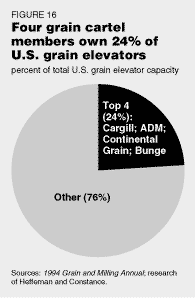
A farmer must sell his grain either to a grain elevator, or, in the rarer
case where he can afford transport, to a grain miller. In either case, it is
a grain cartel company to which he must sell.
By this process, the grain
cartel sets the price to the farmer - at the lowest level possible.
The control apparatus
The control of food for use as a weapon is an ancient practice. The
House of
Windsor inherited certain routes and infrastructure.
One finds the practice
in ancient Babylon/Mesopotamia 4,000 years ago.
In Greece, the cults of
Apollo, Demeter, and Rhea-Cybele often controlled the shipment of grain and
other food stuffs, through the temples.
In Imperial Rome, the control of
grain became the basis of the empire. Rome was the center. Conquered
outlying colonies in Gaul, Brittany, Spain, Sicily, Egypt, North Africa, and
the Mediterranean littoral had to ship grain to the noble Roman families, as
taxes and tribute. Often the grain tax was greater than the land could bear,
and areas of North Africa, for instance, were turned into dust bowls.
The evil city-state of Venice took over grain routes, particularly after the
Fourth Crusade (1202-04). The main Venetian thirteenth century trading
routes had their eastern termini in Constantinople, the ports of the
Oltremare (which were the lands of the crusading States), and Alexandria,
Egypt.
Goods from these ports were shipped to Venice, and from there made
their way up the Po Valley to markets in Lombardy, or over the Alpine passes
to the Rhône and into France. Eventually, Venetian trade extended to the
Mongol empire in the East.
By the fifteenth century, although Venice was still very much a merchant
empire, it had franchised some of its grain and other trade to the powerful
Burgundian duchy, whose effective headquarters was Antwerp. This empire,
encompassing parts of France, extended from Amsterdam and Belgium to much of
present-day Switzerland. From this Venetian-Lombard-Burgundian nexus, each
of the food cartel's six leading grain companies was either founded, or
inherited a substantial part of its operations today.
By the eighteenth and nineteenth centuries, the British Levant and East
India companies had absorbed many of these Venetian operations. In the
nineteenth century, the London-based Baltic Mercantile and Shipping Exchange
became the world's leading instrument for contracting for and shipping
grain.
The five privately held grain companies were carved out from the
centuries-old Mesopotamian-Venetian-Burgundian-Swiss-Amsterdam grain route,
which today extends around the world.
The Big Five are,
-
Cargill
-
Continental
-
Louis Dreyfus
-
Bunge and Born
-
André
The Continental Grain Company is
run by billionaire Michel Fribourg and his son Paul.
Simon Fribourg started
the company in 1813 in Arlon, Belgium. He moved the company to Antwerp, and
then, in the 1920s, to Paris and London. Today, it has a New York office,
along with a strong Swiss-French base.
In 1852, Léopold Louis Dreyfus, who was born in Sierentz, France,
established wheat-trading operations in Basel, Switzerland. In this century,
except during World War II, Louis Dreyfus has been headquartered in Paris
(part of the old Lombard-Burgundian route).
Bunge and Born was founded by the Bunge family from Amsterdam in 1752.
The
company was eventually moved to Antwerp (today it is technically
headquartered in São Paulo, Brazil and the Netherlands Antilles). The André
Company was founded by Georges André in Nyon, Switzerland, and today is
headquartered in Lausanne, Switzerland.
Cargill Company, the world's largest grain company, is based in the
Minneapolis, Minnesota suburb of Minnetonka. It was founded by Scotsman William Cargill, in Conover, Iowa in 1865, and has been run, since the
1920s, by the billionaire MacMillan family.
But the true nexus of Cargill is
in Geneva, Switzerland, where Cargill's international trading arm, Tradax,
Inc., is headquartered, having been established there in 1956 (technically, Tradax is a Panamanian-registered company).
Tradax has divisions all around
the world, including in Argentina, Germany, and Japan. It is the major
source for Cargill's international trading; Cargill has a lot of money
invested in it, and Cargill reaps a large return from Tradax's operations.
Tradax also has partial Swiss ownership. The Lombard, Odier Bank, as well as
the Pictet Bank, both old, private and very dirty Swiss banks, own a chunk
of Tradax.
The principal financier for Tradax is the Geneva-based Crédit
Suisse, which is one of the world's largest money-launderers.
Archer Daniels Midland's purchase of Töpfer, a Hamburg, Germany-based grain
company, vastly increased ADM's presence in the world grain trade.
Töpfer's
trade is situated within the old Venice-Swiss-Amsterdam-Paris routes, and it
has extensive business partnerships with the British Crown jewel, the
Rothschild Bank.
Secret intelligence
The manner in which the grain cartel companies operate is highly secretive.
All but ADM-Töpfer are private companies, and Bush ally and former Cargill
employee Dwayne Andreas runs ADM as his personal fiefdom.
A strategic profile of each of the leading food cartel companies is
contained in the following article, but it is worth noting here a few
critical points about how they work. Much of their workings is shrouded in
mystery, because they release little information to the public. People who
have attempted to write books about the grain companies have spent years
without getting a single interview from any of the reigning grain company
families.
Unlike many American companies, where the founding family has long
since departed the scene, such as in the case of Morgan bank or Chrysler
Corp., the grain cartel companies are run by the same families that have run
them for centuries.
-
the inter-married MacMillan and Cargill families run
Cargill
-
the Fribourg family runs Continental
-
the Louis Dreyfus family runs
Louis Dreyfus
-
the André family runs André
-
the Hirsch and Born families
run Bunge and Born
However, the little that has been gleaned is very revealing.
In 1979, Dan
Morgan wrote The Merchants of Grain, about the world grain trade. He
disclosed that Cargill's Geneva-based trading arm, Tradax, operates not only
such as to park sales of grain in order to escape taxes in the United States
and most countries, but it confounds anyone trying to follow Cargill's grain
movements.
In his book, Morgan reported:
"When Cargill sells a cargo of corn to a Dutch animal-feed manufacturer, the
grain is shipped down the Mississippi River, put aboard a vessel at Baton
Rouge and sent to Rotterdam. On paper, however ... its route is more
elaborate. Cargill first sells the corn to Tradax International in Panama,
which will 'hire' Tradax/Geneva as its agent.
Tradax/Geneva then might
arrange the sale to a Dutch miller through its subsidiary, Tradax/Holland;
any profits would be booked to Tradax/Panama, a tax-haven company, and
Tradax/Geneva would earn only a 'management fee' for brokering the deal
between Tradax/Panama and Tradax/Holland."
While evading taxes and inspection, Cargill also uses its network to move
large shipments of goods anywhere on the globe, on split-second notice.
It
has an in-house intelligence service that matches the CIA's: It uses global
communication satellites, weather-sensing satellites, a database that
utilizes 7,000 primary sources of intelligence, several hundred field
offices, etc.
Cargill is representative of all of the grain companies, and a brief
examination of it gives insight into all the others. Cargill, which had $51
billion in annual sales in 1994, has a dominant position in many aspects of
the world food trade. It is the world's and the United States' number-one
grain exporter, and has a market share of 25-30% in each of several
commodities.
It is the world's,
-
number-one cotton trader
-
the number-one U.S.
owner of grain elevators (340)
-
the number-one U.S. manufacturer of
corn-based, high-protein animal feeds (through subsidiary Nutrena Mills)
-
the number-two U.S. wet corn miller and U.S. soybean crusher
-
the number-two
Argentine grain exporter (10% of market)
-
the number-three U.S. flour miller
(18% of market), U.S. meatpacker (18% of market), U.S. pork
packer/slaughterer, and U.S. commercial animal feeder
-
the number-three
French grain exporter (15-18% of the market)
-
the number-six U.S. turkey
producer
It also has a fleet of 420 barges, 11 towboats, 2 huge vessels
that sail the Great Lakes, 12 ocean-going ships, 2,000 railroad hopper cars,
and 2,000 tank cars.
Cargill has been able to place its people in top posts around the world.
Daniel Amstutz, a 25-year Cargill man, was U.S. Undersecretary of
Agriculture for International Affairs and Commodity Programs in 1983-87,
from which post he decided on the export policy of U.S. grains.
He later
became a leader of the U.S. trade commission in the General Agreement on
Tariffs and Trade (GATT) negotiations on agricultural trade. Meanwhile, the
head of Bunge and Born, Nestor Rapanelli, became Argentina's economics
minister within weeks of Carlos Menem coming in as Argentine President in
1989.
Rapanelli began shifting Argentina from "State intervention to a
'market driven' economy."
Today, Cargill Company is privately owned and run by the MacMillan family.
The MacMillan family's collective wealth, at $5.1 billion, according to the
July 17, 1994 Forbes magazine, is larger than that of the better-known
Mellon family. The MacMillans have always been of service to the British.
John Hugh MacMillan, president of Cargill from 1936 to 1957, and then
chairman from 1957 through 1960, held the title of "hereditary Knight
Commander of Justice in the Sovereign Order of St. John (Knights of Malta),"
one of the British Crown's most important orders.
The drive to the East
The food cartel continues to consolidate its worldwide control in the face
of the oncoming financial disintegration.
In the past four years, the food
cartel has bought up many milling-processing plants and bakeries throughout
the former Soviet Union and East bloc, bringing these nations under tight
food control. Recently, IBP moved to dump cheap Mexican meat there, in order
to bankrupt beef producers.
The Clinton Agriculture Department has brought
them up for investigation.
The food cartel has also built up its control, in the food distribution
industries, through such combines as Philip Morris, Grand
Metropolitan-Pillsbury, and KKR-RJR-Nabisco-Borden. In the case of Philip
Morris, which owns Kraft Foods, General Foods (Post cereals), the Miller
Brewing Company, and a host of other brand names, 10¢ of every $1 that an
American spends on brand-name food items is for a Philip Morris product.
The food cartel's power must be broken. This year, the U.S. Justice
Department's Anti-Trust division launched an investigation into price-fixing
in the case of corn-based fructose and lysine, by Archer Daniels Midland and
some of the other food cartel companies. The case, if brought to trial,
could provide valuable information and help to expose and possibly halt, in
a limited way, a few of ADM's practices.
But the Anglo-Dutch-Swiss cartel is
playing for high stakes - the ability to constrain the supply of raw
materials, and above all, food, to turn back the clock of history, and
reduce mankind from the 5.6 billion population it currently enjoys to the
state of a few hundred million semi-literate souls scratching out a bare
existence.
That assault cannot be fought timidly.
The full truth about the food cartel
must be known.
Back to Contents
Back to
The Black Nobility
Control by the Food Cartel Companies -
Profiles and Histories
by Richard Freeman
This article appeared as part of a feature in
the December 8, 1995 issue of Executive Intelligence Review.
Here are strategic profiles of 11 of the principal companies that constitute
the Anglo-Dutch-Swiss food cartel. The profiles confirm that through
multiple forms of concentration, these companies dominate grain, meat,
dairy, and other food production, and the processing and distribution system
of food, all the way to the supermarket.
Very little food moves on the face
of the earth without the food cartel having a hand in it.
Anglo-Dutch-Swiss food cartel
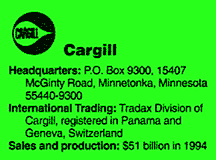
-
#1 U.S. grain trader/exporter (25% of market, which is equivalent to Cargill
exporting 25.1 million tons or 1.0 billion bushels of grain);
-
#1 world grain
trader/exporter (25% of market, which is equivalent to Cargill exporting
52.9 million tons, or 2.11 billion bushels of grain);
-
#1 U.S. owner of grain
elevators (340 elevators);
-
#1 world cotton trader;
-
#1 U.S. manufacturer of
corn-based high-protein animal feeds (through subsidiary Nutrena Mills);
-
#2
U.S. wet corn miller;
-
#2 U.S. soybean crusher;
-
#2 Argentine grain exporter
(10% of market);
-
#3 U.S. flour miller (18% of market);
-
#3 U.S. meatpacker,
through Excel division (18% of market);
-
#3 U.S. pork packer/slaughterer;
-
#3
U.S. commercial animal feeder;
-
#3 French grain exporter (15-18% of market);
-
#6 U.S. turkey producer.
Cargill raises 350,000 hogs, 12 million turkeys, and 312 million broiler
chickens. In the United States, it owns 420 barges, 11 towboats, 2 huge
vessels that sail the Great Lakes, 12 ocean-going ships, 2,000 railroad
hopper cars, and 2,000 tank cars.
Cargill and its subsidiaries operate 800 plants. It has 500 U.S. offices,
300 foreign offices. It operates in 60 countries.
History: Shortly after the Civil War,
William Cargill, a Scottish immigrant
sea merchant, bought his first grain elevator in Conover, Iowa. In 1870,
with his brother Sam, William Cargill bought grain elevators all along the
Southern Minnesota Railroad, at a time when Minnesota was becoming an
important shipping route. But Cargill's biggest break came when he bought
elevators along the line of James J. Hill's Great Northern railroad line,
which went west of Minneapolis, and into the Red River Valley as far as
North Dakota, and also into South Dakota. Hill was the business partner of
Ned Harriman (father of Averell Harriman), who became the business agent for
England's Queen Victoria's son, Prince Edward, later King Edward VII.
Through a preferential rebate system, and other arrangements, Hill's rail
line helped build the Cargill operation.
Twice during the twentieth century, the Cargill firm nearly went under.
William Cargill, Jr., the son of company founder Will Cargill, made some bad
investments in Montana during the first decade of the twentieth century, and
between 1909 and 1917, Cargill hovered on the brink of bankruptcy. Some
British capital came in to rescue the company. William Cargill, Sr. had a
daughter, Edna, who married John MacMillan. The financiers designated John
MacMillan and the MacMillan family to come in and reorganize Cargill. This
was the period in which the MacMillan family started running Cargill.
Cargill also nearly went under following the 1929 U.S. stock market crash,
and ensuing Great Depression. There is not a word of what happened to
Cargill Co. during the depression in the History of Cargill, 1865-1945. But
two forces came to the rescue: John D. Rockefeller's Chase National Bank,
which sent its officer John Peterson to help run Cargill. Peterson became
Cargill's top officer. The other force was a Byelorussian Jewish grain
merchant, Julius Hendel, who joined the company in the late 1920s. It would
seem odd at first that a European, and a Jew at that, would be admitted into
the inner councils of a rock-ribbed Scottish-American firm, but this
indicates the international scope of forces that shape the grain trade.
Hendel would later also school Dwayne Andreas, when Andreas worked for
Cargill after World War II.
During the mid-1930s, Cargill used cut-throat tactics. In September 1937,
corn was a scarce commodity. The 1936 American crop had been a failure, and
the new crop would not be harvested until October. Cargill bought up every
available corn future, to the tune of several millions of dollars, and
created a squeeze on the market. The Chicago Board of Trade ordered Cargill
to sell some of its futures to relieve the squeeze. Cargill refused. The
CBOT expelled Cargill from the Board of Trade. The U.S. secretary of
agriculture accused Cargill of trying to destroy the American corn market.
In 1922, Cargill had opened up a New York office; in 1929, it opened an
Argentine office, and it continued to expand, especially after the Second
World War, as the United States exported large quantities of grain to Europe
and other parts of the globe. In 1953, Cargill established Tradax
International in Panama to run its global grain trade. In 1956, it set up
Tradax Genève in Geneva, Switzerland, as the coordinating arm of Tradax.
Tradax subsidiaries were set up in,
-
Germany (Deutsche Tradax, GmbH)
-
England
(Tradax Limited)
-
Japan (Tradax Limited)
-
Australia (Tradax Limited)
-
France
(Compagnie Cargill S.A.),
...and so forth.
Thirty percent of ownership of Tradax is held by old-line Venetian-Burgundian-Lombard banking families,
principally the Swiss-based Lombard, Odier, and Pictet banks. The financier
for Tradax is the Geneva-based Crédit Suisse, which has been cited
repeatedly for drug-money laundering.
On Feb. 7, 1985, the U.S. government
caught Crédit Suisse and other large banks laundering $1.2 billion in
illegal money - much of it suspected drug money - to the First National Bank of
Boston.
In 1977, Cargill's involvement in a "black peseta"-laundering operation at
Cargill's offices in Spain was revealed.
Cargill has been repeatedly cited for "blending"
- that is, adding foreign
matter to its grain. For example, an export contract may allow for 8% of the
grain volume that a company is exporting to be foreign matter. If Cargill's
grain load is only 6% foreign matter, it will mix in dirt and gravel. A
Cargill superintendent told the Kansas City Times in July 1982, "If we've
got a real clean load, we'll make sure we hold it until we can mix it with
something dirtier. Otherwise, we'd be throwing away money."
Cargill has expanded into every major crop and livestock on the face of the
earth, in over 60 countries. It has also expanded into coal, steel (it is
America's seventh largest steel producer, owning LTV), waste disposal, and
metals. Today, Cargill runs one of the 20 largest commodity brokerage firms
in the United States, trading on the Chicago and world markets, which is
larger than those of most Wall Street brokerage houses. Another division,
Cargill Investor Services, has offices throughout the United States, as well
as in London, Geneva, and Zurich.
Key personnel and policy: The combined Cargill and MacMillan families of
Cargill own 90% of the company's stock (the rest is owned by company
executives). They are one of the ten richest families in America: According
to the July 17, 1995 Forbes magazine, the combined Cargill/MacMillan
families are worth $5.1 billion, making them richer than the Mellons.
Whitney MacMillan, W. Duncan MacMillan, John Hugh MacMillan III, and Cargill
MacMillan, Jr., are each worth $570 million.
The British connections of the MacMillan family are evident. John Hugh
MacMillan II (1895-1960) was the president of Cargill from 1936 until 1957,
and was chairman from 1957 until 1960. He was a hereditary Knight Commander
of Justice of the Sovereign Order of St. John, the chivalric order run by
the international oligarchy grouped around the Anglo-Dutch monarchy. Whitney
MacMillan, chairman of Cargill from 1976 until 1994, was educated at the
exclusive British-modeled Blake School (where the chairman of General Mills
was also educated), and then Yale University.
Showing the link with the gangster-ridden Democratic Party of Minnesota,
Walter Mondale was elected a director of Cargill.
In 1983-84, the family-controlled Cargill Foundation contributed $50,000 to
the University of Chicago's monetarist Economics Department.
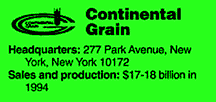
-
#2 U.S. grain trader/exporter (20% of market),
-
#2 world grain
trader/exporter (20% of market) (according to official Continental
documents).
-
#1 U.S. exporter of soybean products and derivatives (through
joint venture called Conti-Quincy Export Co.);
-
#1 world cattle feedlot
operator (7 feedlots in southwestern and plains states of United States);
-
#1
shrimp farm in Ecuador;
-
reportedly #2 French grain exporter;
-
#3 owner of
U.S. grain elevators;
-
#3 or #4 U.S. animal feed manufacturer (through
subsidiary Wayne Feed Division);
-
#3 or #4 world cotton exporter;
-
#8
Argentine grain exporter (7% of market).
Continental processes and markets 2 billion pounds of poultry, beef, pork,
and seafood, along with 5 million tons of animal feeds and wheat flour. The
company transports nearly 75 million tons of grains, oilseeds, rice, cotton,
and energy products annually, an amount that exceeds the annual production
of almost every country in the world.
Continental owns a fleet of towboats and 500 river barges. It owns over
1,500 hopper cars. It has offices and plants in 50 countries, on 6
continents.
History: Simon Fribourg founded the predecessor organization as a
commodity-trading company in Arlon, Belgium in 1813. By the middle of the
nineteenth century, the Fribourg family went into milling, building mills in
Luxembourg and Belgium, especially Antwerp, which, with its deep harbors and
connections to the Rhine River, transported Fribourg flour and wheat to and
from the rest of Europe.
Toward the end of the nineteenth century, Michel
Fribourg, a great-grandson of founder Simon, went with bags of gold to
Bessarabia (today Moldova and Romania) to buy grain. This was a large
grain-producing region. By 1914, the heirs of the family, under the name
Fribourg Frères, moved operations to London, to capitalize on the ability to
trade grain internationally. In 1920, the headquarters moved again, this
time to Paris, and the company's name changed to Compagnie Continentale.
Thus, 100 years after its founding in 1813, the Continental Company had
established firm links into the cities and channels of the European grain
trade, as well as to Australia, through London.
In 1921, the Continental Company opened an office in Chicago, and another in
New York. In 1930, it leased a terminal in Galveston, Texas. During the
Depression of the 1930s, the Continental Company made out like bandits. As
reported in one history, the head of the family, Jules Fribourg, instructed
his New York agent to buy Midwest grain elevators, which were at depressed
prices, with the instructions, "Don't bother to look at them - just buy them."
The Fribourgs lived very, very well. René Fribourg, the co-head of the
company, lived like a Medici prince, collected gold snuff boxes and Louis XV
and Louis XVI furniture, and dined off eighteenth-century china. But when
the Nazi Army invaded France in June 1940, the Fribourgs fled to America.
In 1968-69, the Fribourgs, working with the Cargill company, and through an
agent of the grain cartel in the U.S. Department of Agriculture, Clarence
Palmby, helped destroy the American merchant fleet, by convincing President
Nixon that the "50-50" provision, by which half of all American grain
exports had to be carried on American vessels, should be abolished, in order
to land a large Russian grain deal. Almost all of the grain went on
Russian-bottom boats. Various favors paid off, for, in 1973, the Russians
rewarded Continental by making an unprecedented purchase from the company of
6 million tons of grain and soybeans. The head of Continental was and
remains Michel Fribourg. His personal financial adviser, Sasha Maximov, was
the son of the last czarist ambassador to Constantinople, a post usually
held by a Venetian agent.
In 1976, Continental was fined $500,000 for short-weighting ships. In the
late 1970s, when Zaire, which was very poor, was unable to pay its bills,
Continental cut off food shipments to that starving nation. In the 1970s,
Continental became the first grain company to sell grain to China.
Key personnel and policy: The heir apparent of the company is Michel
Fribourg's son, Paul, who, at the age of 41, is president of Continental.
Michel Fribourg, great-great-grandson of Continental's founder, and his
immediate family, own 90% of Continental's stock (other members of the
Fribourg family own the rest). The Oct. 17, 1994 issue of Forbes magazine
lists the worth of Michel Fribourg alone at $1 billion.
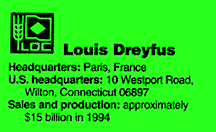
-
#1 French grain exporter;
-
#3 world grain exporter;
-
#4 U.S. grain exporter;
-
#5 Argentine grain exporter (8% of market);
-
#1 world exporter of grain to
Russia.
Louis Dreyfus operates 47 vessels - bulk carriers, lakers, panamaxes, and
chemical and natural gas carriers - worldwide.
History: Léopold Louis Dreyfus, who was born in Sierentz, France, set up his
wheat trading operations in Basel, Switzerland, at the age of 19, in 1852.
He bought wheat from Vojvodina plain, which went to Budapest, Hungary, for
milling, then the milling capital of the world. He also purchased grain from
Moldova and Wallachia (present-day Romania) and shipped it to Liverpool for
milling. In the process, he became close friends with King Carol I of
Romania, whom he charmed so much that he was appointed a councillor at the
king's court. In the first decade of the 1900s, Léopold Louis Dreyfus was
appointed Romania's consul to Paris.
Léopold Dreyfus also invested heavily in grain elevators and the grain trade
in Odessa, Ukraine. He began importing Russian wheat into Marseilles,
France. Toward the end of the nineteenth century, he was marketing grain
through a network of offices in Hamburg, Bremen, Berlin, Mannheim, Duisburg,
in Germany, and Paris, thus having a healthy share of the German market.
Léopold Louis Dreyfus expanded into corn, barley, and other crops, and as a
wholesaler of grain, dealt with Canada, Australia, and the United States. He
moved to Paris, married a Florentine baroness, and ran a newspaper,
L'Intransigent.
In the 1940s, the company was run by Jean, François, and Pierre Louis
Dreyfus. After the Nazis liquidated France's Vichy government in 1942, Jean
and François left for Argentina and Pierre for London.
Louis Dreyfus, although privately owned, is also a cooperative under French
law. It owns 49% of the shares of the co-op Union Française des Céréales (UFC,
better known as La Cooperative Lafayette). Under this arrangement, UFC sells
French grain exclusively for itself and Dreyfus, both within the European
Union and to third markets. This allows Dreyfus to obtain credit at low
interest rates from the quasi-official French banking institution Crédit
Agricole, which terms are not available to purely private corporations.
Louis Dreyfus also has a bank bearing its name, which in the 1970s rose to
become the fifth largest private bank in France.
Key personnel and policy: The current head of the company is Gerard Louis
Dreyfus. Gerard is the son of Pierre Louis Dreyfus and Pierre's first wife,
who was the daughter of an American industrialist. Gerard was educated in
the United States, attended Duke University, attended law school, and worked
for a while at the organized crime-connected law firm Dewey Ballantine.
Gerard now resides in France, and by conservative estimates, he and his
immediate family are worth $0.5-1 billion.
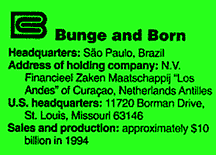
-
#1 U.S. dry corn miller (through its subsidiary, Lauhoff Grain) (18% of the
market);
-
reportedly #1 Brazilian grain exporter;
-
#2 U.S. soybean products (soymeal
and soy oil) exporter;
-
#3 U.S. grain exporter; #3 U.S. soybean processor;
-
#4
world grain exporter;
-
#4 U.S. grain elevator capacity;
-
#7 Argentine grain
exporter.
Bunge operates 50 grain elevators in the United States, most of them located
along the Mississippi River from St. Louis to New Orleans. It also has a
giant grain export elevator in Quebec City, Canada.
History: In 1750, in Amsterdam, the Bunge family had started trading hides,
spices, and rubber from Dutch overseas colonies. After a century of
lucrative trade in this area, in 1850, Charles Bunge moved the family
business to Antwerp, Belgium. Charles's two sons established a merchant
monarchy straddling the Atlantic Ocean. Edouard Bunge stayed in Antwerp, and
Ernest Bunge emigrated to Argentina in 1876. With his brother-in-law George
Born, Ernest established the firm Bunge and Born. In 1897, a Mannheim Jewish
grain trader by the name of Alfred Hirsch joined the firm in Buenos Aires.
In 1927, Hirsch became president of Bunge and Born, and held that position
for 30 years.
Hirsch and others at Bunge and Born accumulated estancias
- plantations of
hundreds of thousands and even millions of acres of land, many in the rich
soil region of the Pampas plains. The extent of Bunge and Born domination of
the Argentine economy was revealed in 1974, when the Montoneros terrorists
kidnapped the heirs to the firm, Jorge and Juan Born, and held them for many
months. During the time that the brothers were held in captivity, they
revealed that Bunge and Born not only dominated Argentina's agriculture, but
also that Bunge companies produced 40% of Argentina's paint, one-third of
its tin cans, 20% of its textiles, etc.
Argentine President Juan Perón attempted to suppress the power of Bunge and
Born and other grain cartel companies in Argentina. When Perón became
President for the first time in 1946, he moved to have the government buy
the grain from the Argentine farmer and export it. The profits were used to
finance the industrialization of Argentina. In 1948, he established the
Institute for the Promotion of Trade (IAPI) to achieve this purpose.
However, the grain cartel companies, weakened by Perón's reforms, wanted him
out of power. In 1955, Perón was deposed and the IAPI system he had set up
was disbanded. When Perón returned to power in 1973, he established a
National Grain Board for the same purpose. Again, Perón was fiercely opposed
by the grain cartel companies. He died in 1974, and was succeeded by his
wife, Evita. In 1976, Evita Perón was overthrown. The National Grain Board
was dismantled, and control of grain and meat exports was returned to the
private grain companies.
In the meantime, Bunge diversified a large share of its capital into Brazil
and the United States. However, the power of Bunge and Born is still strong
in Argentina. The first two ministers of economy in the government of
President Carlos Menem, were executives of Bunge and Born, first Mor Roig,
and Nestor Rapanelli.
Key personnel and policy: The Born and Hirsch families, which run Bunge and
Born today, are each conservatively estimated to be worth half a billion
dollars.
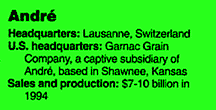
History: Founded in 1877 by
George André in Nyon, Switzerland. He imported
hard durum wheat for pasta from Russia. The grain was unloaded at Marseilles
and railed up to Switzerland. In 1937, Frederic Hediger, also Swiss, came to
the United States and founded Garnac, using money from George André. Garnac
became a subsidiary of the André Holding Company. In the 1970s, André was
accused, along with Bunge Company, of wrecking the Spanish corn growers by
importing corn at low prices into Spain from the United States. During the
1970s, after an embargo had been placed on the commercial activities of what
was then Rhodesia (now Zimbabwe), André helped sell Rhodesian grain on the
world market through illegal channels.
Key personnel and policy: Georges André, a member of a very strict Calvinist
sect, lived, until he died in 1942 at the age of 86, in an Alping chalet in
Gstaad, Switzerland. His neighbor was Axel Springer, the German publishing
mogul. André's three sons, Henri, Pierre, and Eric, inherited the company.
The André family is conservatively estimated to be worth more than $0.5
billion.
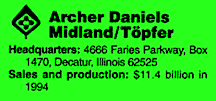
-
#1 U.S. soybean crusher (between 30 and 35% of market);
-
#1 U.S. wet corn
miller (approximately 50% of market);
-
#1 world processor of combined grain
and oil seed;
-
#1 world producer of ethanol;
-
#1 U.S. producer of corn-based
additive (60% of market);
-
#2 U.S. flour miller (23% of market);
-
#2 in U.S.
grain elevator capacity;
-
#3 U.S. dry corn miller, through subsidiary Krause
Milling (10% of market);
-
#5 or #6 world grain export trader (combined ADM
and Töpfer) (9% of market).
ADM/Töpfer makes enough flour every year to bake 16 billion loaves of bread
and enough soybean meal to feed 13 billion chickens - twice as many broilers
as the United States produces.
History: In 1878, John W. Daniels began crushing flaxseed to produce linseed
oil and in 1902 formed Daniels Linseed Company in Minneapolis. George A.
Archer, another experienced flaxseed crusher, joined the company in 1903. In
1923, the company bought Midland Products and adopted the name Archer
Daniels Midland (ADM).
In the United States, the use of the soybean had been pushed by Dr. John
Harvey Kellogg, brother of the Battle Creek, Michigan cereal magnate and a
leading exponent of the cultish health-food "wellness" movement. Dwayne
Andreas, who was born into a Mennonite family in Decatur, Illinois in 1918,
joined his father's R.P. Andreas firm in the mid-1930s. In 1936, the Andreas
family changed the name of the firm to the Honeymead Company, and in 1939,
Honeymead began to diversify from linseed crushing to soybean crushing. In
1945, when Dwayne Andreas thought he was about to be drafted - by this time he
was chief executive officer of Honeymead - he sold 60% of the family's
Honeymead to Cargill.
From 1946 through 1952, Dwayne Andreas worked for Cargill, learning how to
hedge and speculate in commodities from Julius Hendel, a top European Jewish
grain trader who came to the United States to help salvage Cargill from
disaster in the 1930s. In 1945, Dwayne Andreas met Hubert Humphrey, who was
tied into organized crime. Andreas contributed $1,000 to Humphrey's first
senatorial campaign in 1948. Later, writing about this contribution,
Humphrey called it a "spectacularly large amount." Humphrey and Andreas
became intimate. Humphrey was godfather to Andreas's son. Former U.S. House
Speaker Tip O'Neill said of Andreas, "Hubert was his first love." In 1977,
Humphrey, then on the Senate Agricultural Committee, wrote legislation to
establish government supports for sugar, which saved Andreas from huge
losses. In the 1980s, Andreas funded a Hubert Humphrey Room at the
Anti-Defamation League's new headquarters at U.N. Plaza in New York City.
While Humphrey lived, Andreas and Humphrey took 85 trips together.
In 1974, ADM entered into a price-fixing scheme that overcharged the U.S.
government $19 million in sales of soy-fortified food to the Food for Peace
program. As one reporter commented, the money was stolen "either from the
taxpayers or the starving poor, depending on which devout Mennonite
perspective you prefer." ADM was convicted. In 1976, the company pleaded no
contest to federal charges that it had systematically short-weighted and
misgraded federally subsidized grain that was being shipped abroad.
Andreas's investment in high-fructose corn syrup (HFCS) production
prospered, when the soft-drink industry bought it. By 1983, HFCS accounted
for 75% of sweeteners purchased by Coca-Cola and 50% of Pepsi's sweeteners.
Andreas became deeply involved in grain sales to Russia and was active in
the U.S.-U.S.S.R. Trade and Economic Council, eventually becoming USTEC's
chairman. In 1984, Andreas met Mikhail Gorbachov for the first time. In
1990, Andreas contributed $1 million to create a Gorbachov Institute in the
United States and Russia.
ADM purchased a 50% stake in Alfred C. Töpfer International, one of the most
powerful second-tier grain cartel companies. This purchase also works the
other way, with the older, Hamburg-based Töpfer Company, with extensive
roots in Europe, exercising an influence over ADM. The Töpfer Company has an
over 70% equity position in two French firms - Compagnie Européene des
Céréales and G. Muller. The remaining shares in these companies are held by
the Rothschild Group in France. These two French companies and the Töpfer
Company own at least ten large grain elevators in France and Germany. Also,
before the Iron Curtain came down, Töpfer controlled 50% of the grain
imports into East Germany.
Andreas was always close, as a result of his friendship with Hubert
Humphrey, to the organized crime-linked Anti-Defamation League of the B'nai
B'rith. During the 1980s, Andreas was persuaded by another major grain
trader, Burton Joseph, of the Minneapolis-based S.I. Joseph Company, to
contribute $1 million to the ADL. Andreas made the payments in amounts of
$50,000 to $100,000 per year.
In 1995, the U.S. Justice Department launched an investigation into fraud
and anti-competitive price-fixing in ADM's handling and marketing of corn
sweeteners and lysine. The latter enhances growth in chickens and hogs,
while making meat leaner.
Key personnel and policy: Board of directors: Howard Buffett, vice president
of ADM and son of Berkshire Hathaway (men's clothing brand) owner Warren
Buffett (at the beginning of the Justice Department's investigation, Howard
Buffett resigned from ADM board); Robert Strauss, George Bush's ambassador
to Russia, 1991-93, and a long-time friend of Andreas. Strauss is also a
member of the board of British intelligence's chief propaganda mouthpiece,
the Hollinger Corp.; Brian Mulroney, former prime minister of Canada, and
associated with the Hollinger Corp.; several members of the Andreas family,
including Dwayne's brother Lowell Andreas, and his son, Michael Andreas, who
is also ADM's vice chairman and the heir apparent.
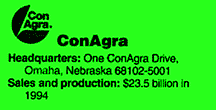
-
#1 U.S. flour miller (24% of market);
-
#1 U.S. sheep slaughterer (33% of
market), through Sipco and Montfort meats;
-
#2 U.S. beef slaughterer (20% of
market);
-
#2 U.S. pork slaughterer;
-
#4 U.S. dry corn miller (8% of market);
History: ConAgra was founded in Omaha, Nebraska in 1919 as Consolidated
Mills, a grain processor. (The name was changed to ConAgra in 1971.) In
1982, ConAgra bought the Peavey Company. Peavey, along with its Minneapolis
confederates, the Pillsbury and Washburn families, dominated the milling of
American flour, which came up the Mississippi River or along the railroads
from the American Midwest to Minneapolis. This immediately made ConAgra
America's largest flour miller. This was followed by a slew of purchases in
the meatpacking industry, including Armour (1983), Northern States Beef
(1985), E.A. Miller (1987), Montfort (1987), and Swift (1987).
The purchase of Montfort Meats typifies the takeovers in the meat industry.
The Colorado-based Montfort Meats was America's third largest meatpacker,
and an independent. In 1986, Cargill Meat Company made a bid for Spencer
Beef. Montfort Meats took legal action to block the takeover, on the grounds
that it would make Cargill too large in the meatpacking industry, and thus
it clearly violated U.S. anti-trust laws. Even though a local court and a
district court ruled in Montfort's favor, the U.S. Supreme Court upheld the
takeover. Fearing it was just a matter of time, and that it could not
survive on its own, Montfort tendered itself for takeover to the giant
ConAgra.
ConAgra also bought Elders, the largest beef producer/processor in Australia
and the largest beef and lamb exporter in the world. ConAgra continued its
takeover binge: Since the mid-1970s, ConAgra has acquired over 100
companies. It bought the Chung King line of foods; Beatrice Foods, including
Butterball Turkeys; Peter Pan peanut butter, and others.
Major brands: Hunt's Tomato Sauce and Ketchup; Wesson Oil; Banquet TV
dinners; Armour, Swift, Eckrich, and Hebrew National meats; Healthy Choice
foods; Orville Redenbacher popcorn; Peter Pan peanut butter; LaChoy Chinese
foods; Swiss Miss cocoa; Reddi-Whip whip cream.
Key personnel and policy: Board of directors: Dr. Ronald Roskens, president
of Action International, former president of the University of Nebraska,
reportedly dismissed for pedophilia, and George Bush's director of the State
Department Agency for International Development; Marjorie Scardino, chief
executive of the Economist Newspaper Ltd. and Economist magazine, which is
jointly owned by Britain's Rothschild and Lazard Frères banking houses, both
close to Britain's royal family; Charles Harper, chairman and chief
executive of RJR Nabisco.

IBP, the largest butcher in the world, accounts for 9 billion
pounds of meat a year, or about 14% of U.S. total. Japan, which consumes
half of all U.S. meat exports, is a major market for IBP.
IBP was bought in 1981 by Armand Hammer's Occidental Petroleum Corp.
Occidental sold 49.5% of the company in 1987, and the remaining 50.5% of IBP
in 1991. FMR Corp. is the holding company for Fidelity Mutual Funds, the
largest family of mutual funds in the United States, with over $300 billion
in investments. FMR Corp. is run by Boston Brahmin oligarchical families,
and owns 13% of IBP's stock. FMR is also a large owner of raw material
cartel companies, including shares of 5% or more in: Homestake Mining, Coeur
D'Alene Mines, and Santa Fe Pacific Gold Corp., three of the largest
gold-mining companies in the United States.
History: Formed in 1960 by A. Anderson and
C. Holman, as Iowa Beef
Processors; the first plant was in Denison, Iowa. IBP broke with tradition:
It built the plant in a rural area where the cattle was raised. In 1967, it
took another step: Its Dakota City, Nebraska plant cut the meat and shipped
it, pre-cut, in vacuum packs to stores (called boxed beef). IBP reached a
marketing agreement with Cactus Feeders, the nation's largest commercial
feeder, to supply it with beef cattle. In the early 1990s, it purchased 40
hog-buying stations from Heinhold Hog, Inc. in Missouri, Iowa, Nebraska,
South Dakota, and Minnesota.
IBP makes money by driving down the wages of its workforce and the price of
beef paid to farmers. IBP tried to ban union wages and the union. In 1965, a
strike against this IBP policy became so violent that the governor of Iowa
had to intervene to settle it. A 1969-70 strike, provoked by IBP, resulted
in one death. A similar pattern prevailed in the 1980s. On Aug. 15, 1995,
the Wall Street Journal reported: "In May, the Immigration and
Naturalization Service arrested 24 illegal aliens, who worked for an IBP
contractor, at the company's Council Bluffs plant: a month earlier, 35
illegals were arrested at an IBP plant in Minnesota."
For the third quarter of 1995, IBP's net income/profit rose to $85.4
million, an increase of 74% from its net income of $49.2 million during the
third quarter of 1994. But IBP's quarterly sales, for the third quarter of
1995, were virtually the same as those of the third quarter of 1994, $3.3
billion and $3 billion, respectively. So how did IBP nearly double profits
on the same sales volume? By driving down the price of beef paid to the
farmer. It is now $60 per hundredweight of beef, when a price of $75 to $80
is needed for cattle ranchers to break even. Cattle ranchers are not
selling, because they can't afford to accept the low price.
IBP attempted to get its meat into the New York market by forming ties with
the Mafia, which was exposed in trials in the 1980s.
Key personnel and policy: Board of directors: Wendy Graham, wife of the
budget-cutting lunatic Sen. Phil Gramm (R-Tex.). From 1988 to 1993, Wendy
Gramm was George Bush's chairman of the Commodity Futures Trading
Commission, during which time derivatives holdings at large U.S. financial
institutions exploded from $2.5 billion to over $20 billion. In August of
this year, IBP offered free tickets and bus transportation to its employees
(paid for by the Gramm campaign), if they would go to the Iowa Republican
Party Presidential straw poll and vote for candidate Phil Gramm, whom IBP
backs, over local favorite, Kansan Bob Dole. Also on IBP's board is Alec Courtelis, a Florida real estate developer and the nation's largest Arabian
horse breeder. Courtelis was National Finance co-chairman of the 1992
Bush-Quayle campaign, and is now Finance Committee head of the Gramm for
President campaign and chairman of the Armand Hammer United World College.
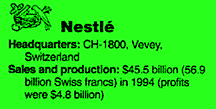
-
#1 world food company;
-
#1 world trader in dry milk powder;
-
#1 world trader
of condensed milk;
-
#1 seller of chocolate and confectionary products;
-
#1
world seller of mineral water;
-
#3 U.S. coffee firm.
In 1994, there were 13 countries in which Nestlé had 1 billion Swiss francs
or more in sales; the countries (with sales in billions of Swiss francs in
parenthesis): U.S. (SF 12.2); France (SF 6.5); Germany (SF 6.1); U.K. (SF
3.3); Italy (SF 3.2); Japan (SF 3.1); Brazil (SF 2.9); Mexico (SF 1.8);
Spain (SF 1.8); Australia (SF 1.1); Switzerland (SF 1.1); the Philippines
(SF 1.1); Canada (SF 1.0). Nestlé's has 400 manufacturing facilities on 5
continents.
History: In 1866 in Cham, Switzerland,
Charles Page founded the Anglo-Swiss
Condensed Milk Company. In 1867, in nearby Vevey, Henri Nestlé founded
Farine Lactée Henri Nestlé. In 1905, Nestlé and the Anglo-Swiss Condensed
Milk Company merged.
In 1922, a banker, Louis Dapples, took over management of the company, and
eventually became chairman of Nestlé. Over the next 70-odd years, Nestlé
made one takeover after another, especially during the past ten years. It
controls the export of powdered milk to the developing sector.
Brand names: Nestlé's chocolate mix and chocolate milk; Nestlé's candy bars,
including Crunch, Butterfinger, Kit-Kat, After Eight dinner mints; Peter-Cailler-Kohler
Chocolats; Perrier, Vittel, Fuerst Bismarck, Spring, Arrowhead, and other
brands of bottled mineral water; Libby fruit juices; Hills Brothers, Zoega,
and Dallmayr roasted coffee; Carnation sweetened condensed milk and
Carnation breakfast bars; Coffee-Mate creamer; Stouffer's restaurants,
frozen foods, and other products; Findus and Surgela frozen products in
Europe; Nescafe instant coffee; Taster's Choice coffee; Nestea instant tea;
Buitoni spaghetti and Contadina tomato paste, sauce, and Italian food
products; Friskies cat food; and Alpo dog food.
Nestlé's also owns Alcon eye products, such as Opti-Free, and 26.3% of
L'Oreal, the world's largest shampoo and cosmetics company.
Key personnel and policy: Board of directors: Nestlé chairman Helmut Maucher
is also on the board of J.P. Morgan Bank, British intelligence's leading
bank in the United States, and Allianz Versicherung of Munich, an insurance
firm; Fritz Leutwiller, who was also chairman of Swiss National Bank and, in
1982-84, of the Bank for International Settlements, the central bank of the
central banks; Paul Volcker, chairman of U.S. Federal Reserve Board of
Governors 1978-85, currently chairman of Blackstone Group, a Wall Street
investment firm.
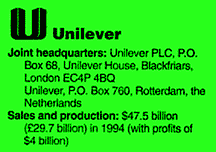
-
#1 world producer of ice cream;
-
#1 world producer of margarine;
-
one of the
top five world exporters of dry milk powder;
-
#1 European tea seller;
-
#2 or
#3 world producer of soaps and detergents;
-
one of the top five world
crushers of palm oil and palm kernel;
-
one of world's largest producers of
olive oil.
History: In 1885, Englishman William Lever and his brother James formed
Lever Brothers. It produces Lux, Lifebuoy, Rinso, and Sunlight soaps. In the
Netherlands, rival buttermakers Jurgens and Van den Berghs were pioneers in
margarine production. In 1927, they created the Margarine Union, a cartel
that owned the European market. In 1930, the Margarine Union and Lever
Brothers merged, forming Unilever. This paralleled the merger of Royal Dutch
Oil Company and Britain's Shell Transport Company at the turn of the
century, to form the Royal Dutch Shell Oil Company, the world's largest.
Both Unilever and Royal Dutch Shell are corporate entities that express the
joint interests of the Anglo-Dutch monarchies.
Brand names: Breyers, Good Humor, Klondike, Magnum, Carte D'Or, and Popsicle
brands ice cream; Bird's Eye and Iglo frozen foods; Ragú and Chicken Tonight
pasta and meal sauces; Lipton Tea and Brooke Bond Tea (leading European tea
company); Lipton soups; Continental Cup-a-Soup; Country Crock, Blue Bonnett,
Flora, Becel and Rama margarines; Bertoli and La Masia olive oil; Wishbone
salad dressing; Boursin and Milkana cheeses; Bon Vivant cookies; Pepsodent,
Close-Up, and Mentadent tooth pastes; Dove, Lux, and Lever soaps; Wisk and
Surf laundry detergents; Vaseline Intensive Care, Pond's Cold Cream,
Elizabeth Arden, Fabergé (Brut, Chloe) and Calvin Klein skin care cosmetics.
Key personnel and policy: Board of directors: Lord Wright of Richmond, GCMG,
from 1986-91, permanent undersecretary of state at the British Foreign and
Commonwealth Office and head of the Diplomatic Service, also a director of
Barclay's Bank; Sir Derek Birkin, from 1985-91, chairman of London-based RTZ
(Rio Tinto Zinc), the world's second largest mining company, in which the
Queen of England has a substantial investment; Frits Fentener Van
Vlissingen, from 1974 through 1991, member of the Supervisory Board of the
giant Rotterdam Bank of the Netherlands; Sir Brian Hayes, former permanent
secretary of Britain's Ministry of Agriculture; Viscount Leverhulme, KGTD,
grandson of William Lever, largest stockholder in Unilever, and funder and
builder of Prince Philip's World Wide Fund for Nature (WWF), the
coordinating arm for British intelligence.
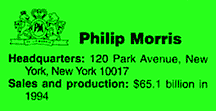
-
#2 world food company;
-
#1 U.S. food company (10¢ of every $1 Americans spend
on branded food items in the United States is for a Philip Morris/Kraft food
product);
-
#1 world processed cheese seller;
-
#1 world cream cheese seller;
-
#1
U.S. seller of luncheon meats;
-
#1 U.S. seller of powdered soft drinks;
-
#1
world cigarette producer;
-
#1 U.S. and Japan cigarette producer (44.8% of
U.S. market);
-
#2 U.S. beer brewer, through Miller Brewing;
-
#3 world beer
brewer;
-
#3 world confectionery business;
-
#3 U.S. breakfast cereal company
(Post cereals).
History: In 1847, Philip Morris opened a London tobacco store, and by 1854
he was making his own cigarettes. In 1919, U.S. financier George Whelan
purchased the rights to market Philip Morris brands such as Marlboro, Ovals,
Players, and Cambridge. Ten years later, Whelan's successor began
manufacturing the cigarettes in Richmond, Virginia.
In 1985, Philip Morris bought General Foods, producer of Jello brand gelatin
and Post cereals, for $5.75 billion. In 1988, Philip Morris spent $12.9
billion to acquire Kraft Foods.
Brand names: Kraft Products, such as Kraft Mayonnaise and Miracle Whip and
Kraft cheese; Velveeta; Philadelphia Cream Cheese; Dairylea; Cool Whip; Post
cereals; Entenmann's Cookies; Jello; Kool-Aid, Country Time, Crystal Light
and Tang powdered drinks; Maxwell House, Sanka, Maxim, Gevalia, Jacobs,
Kaffe Hag, and Carte Noire coffees; Milka and Toberlone confectionery
chocolates and candies; Jacobs Suchard, a Swiss maker of chocolate and
coffee (Philip Morris bought it in 1990; Jacobs Suchard is one of the ten
largest European food companies); Tombstone Pizza; Miller, Miller Lite,
Molson, Lowenbrau, Red Dog beers; Oscar Mayer, Louis Rich, Simmenthal and
Negroni lunch meats; Lender's Bagels; Budget Gourmet frozen dinners; Shake
N' Bake; Stove Top Stuffing; Log Cabin syrup; Good Seasons salad dressing;
Marlboro, Lark, Philip Morris, Benson and Hedges, Chesterfield, Virginia
Slims, Merit cigarettes.
Key personnel and policy: Board of directors: Rupert Murdoch, chairman of
the News Corporation. The Australian-born Murdoch runs major propaganda
organs for the British, including his company's flagship newspapers, the
Times and Sunday Times of London; Richard Parsons, president of Time Warner.
The publisher of Time magazine and of Warner records, Time Warner is
partially owned by the mob Bronfman family of Seagram's Liquor, which family
is reputedly a major force in the world's illegal narcotic trade; Stephen
Wolf, senior adviser of Lazard Frères investment bank.
Philip Morris is one of the largest corporate sponsors of Prince Philip's
WWF. It is one of the largest smugglers of illegal cigarettes, both for sale
and as barter for other illegal goods. It has been cited repeatedly in the
Italian press as one of the world's largest marijuana dealers.
Back to Contents
FOCUS - LESTER BROWN AND DENNIS AVERY
The Cartel 'Experts' Decide Who Eats
by Charles Tuttle and Marcia Merry Baker
This article appeared
as part of a feature in
the
December 8, 1995 issue
of Executive Intelligence Review.
See Feature
Introduction and Table of Contents.
Among the most prominent of the so-called experts on food and agriculture
policy that you are likely to see yakking in your newspaper and on
television, are Lester Brown and Dennis Avery.
Their notoriety does not
reflect aggressive public relations work, but rather the fact that these
individuals are the figureheads for 20-year-old propaganda machines that are
"approved" and bought and paid for by the commodities cartel interests.
Brown, who heads up the Washington, D.C.-based Worldwatch Institute, and
Avery, head of the Virginia-based Center for Global Food Issues, a division
of the Indianapolis-based Hudson Institute, are usually portrayed, like
Punch and Judy, as having opposing viewpoints, usually "left" and "right,"
respectively. However, they serve the same interests, and their job is to
lecture, travel, and issue reports on food, agriculture, and related
matters, in such a way as to manipulate public opinion favorably to cartel
interests.
The characteristic Brown line is that world population numbers have exceeded
the world's natural resources base, and population must be cut. And to
"save" the world's environment, Brown demands that the use of advanced
agriculture technology be limited to only certain people and places
(determined by the food commodities cartel companies).
The characteristic Avery line is that the world can support billions more
people, as long as free trade rights are extended to certain people and
companies (of the food cartels), which will provide the needed food. He
sings the praises of biotechnology, i.e., the particular advances whose use
and patent rights are controlled by the cartel companies.
What Brown, Avery, and others like them have in common, is that they never
name the names of the individuals, corporations, and entities that gain from
food commodities control. Both Brown and Avery were created as bogus food
"authorities," by these interests.
Here we provide the background, funding, and pedigree of Brown and Avery,
and report on some of their propaganda activities in 1994-95.
Lester Brown
Lester Russell Brown has been president of the
Worldwatch Institute since
its creation in 1974. Often called "Dr. Doom," or "God's Scorekeeper,"
Brown's entire career is associated with Worldwatch Institute, which was
created for propaganda purposes.
Brown was born in New Jersey in 1934, and
was elevated into his role as an "agriculture authority" as a young man in
Washington, D.C. in the 1960s.
Funding: The 1974 start-up grant for Worldwatch Institute was $500,000
provided by the Rockefeller Brothers Fund. The chief funders of Worldwatch
over the succeeding years include the following foundations: Ford,
Rockefeller, John D. and Catherine T. MacArthur, Andrew W. Mellon, [Ted]
Turner, William and Flora Hewlett, Charles Stewart Mott, Geraldine R. Dodge,
Edward John Noble, W. Alton Jones, Curtis and Edith Munson, Frank Weeden,
Energy, George Gund, Surdna, Public Welfare, and Edna McConnell Clark.
Other Worldwatch funding agencies include the U.N. Environment Program, the
U.N. Population Fund, the Rockefeller Brothers Fund, the Winthrop
Rockefeller Trust, the Lynn R. and Karl E. Pickett Fund, the Robert R.
McCormick Charitable Trust, and the Pew Charitable Trusts.
Associations: Brown is a member of the following groups: New York Council on
Foreign Relations, Zero Population Growth, Common Cause, and World Future
Society. He is a board member of the Institute of 21st Century Studies, the
Population Reference Bureau; and an advisory council member of the
Commission of National Institutions for the Environment. He is on the
advisory committee of the Institute of International Economics, a consulting
group run by C. Fred Bergsten of the Trilateral Commission, which acts in
close association with the International Monetary Fund.
Education: B.S. from Rutgers University; masters degree in agriculture
economics from the University of Maryland, 1959; masters degree in public
administration from Harvard University, 1962.
Background: Brown worked at the U.S. Department of Agriculture in
Washington, D.C. in 1959-69, starting out as an analyst for international
agriculture in 1959-63, and otherwise working in the USDA Foreign
Agriculture Service. During this period, Brown was groomed for service by
Secretary Orville L. Freeman.
Freeman, secretary of agriculture in the 1960s, was in turn beholden
- as he
is to the present day - to the London-centered financial and food commodities
interests operating out of Minnesota, Freeman's home state. Freeman started
out as a lawyer in 1947, and was elected governor in 1955. He was part of
the Hubert Humphrey political machine, including all its connections to
organized crime and international free trade. Freeman has served as chairman
of the Worldwatch Institute's board of directors for its entire 20 years,
and serves on many similar boards, for example, the Club of Rome-linked
World Future Society. The World Future Society is one of the biggest
proponents of the insane "Third Wave" theory that society has gone into a
post-industrial epoch, peddled by Alvin Toffler and Newt Gingrich.
In 1964-66, Brown was given the role of adviser on foreign agriculture
policy to Agriculture Secretary Freeman. Then, after another Freeman
appointment, Brown served as administrator of the USDA International
Development Service in 1966-69. Brown went on to help found and work with
the Overseas Development Council (ODC), started in 1969 with the backing of
many private corporations, foundations, and individuals; Freeman was on the
board, James P. Grant was president, and Theodore Hesburgh was chairman of
the board. Brown calls this period with the ODC (1969-74) "the beginning of
26 rewarding years spent on Massachusetts Avenue's 'think-tank row.' "
Worldwatch chroniclers like to cite a specific discussion that Brown had
with William Dietel, vice-president of the Rockefellers Brothers Fund, at
the Aspen Institute in Aspen, Colorado in the summer of 1973, as the point
of origin of the founding of Worldwatch. They cite the men's "shared common
interests in forming a small research institute to do integrated study and
analysis of global issues," specifically environmental and environmentally
related issues.
During the early 1970s, Brown was active in many locations. He was faculty
member, Salzburg Seminar in American Studies, summers 1971 and 1974; guest
scholar, Aspen Institute, summers 1972-74. (He was MacArthur Foundation
fellow in 1986.) In 1974, the Worldwatch Insitute was officially created.
These Aspen Institute links are critical. Aspen was founded by Robert
Maynard Hutchins, the longtime chancellor of the University of Chicago, who
was the leading American ally of the late Lord Bertrand Russell, the
international socialist who advocated the elimination of science and the
systematic elimination of the darker-skinned races. To this day, Aspen is
one of the leading Malthusian policy snake-pits in the world, peddling the
idea of "food as a weapon."
Awards: 1965 USDA Superior Service award; 1965 Arthur S. Flemming award, for
one of 10 outstanding young men in federal government; 1981 A.H. Boerma
award of the United Nations Food and Agriculture Organization; 1982 National
Wildlife Federation Special Conservation award; 1985 Lorax award of Global
Tomorrow Coalition (the group associated with the Malthusian Donald Lesh and
Club of Rome); 1986 MacArthur Foundation "Genius" fellowship award; 1989
World Wide Fund for Nature International award; 1989 U.N. Environment Prize;
1991 American Humanist Association, "Humanist of the Year"; 1991 Pro Mundo
Habitabili award of King Carl XVI Gustav of Sweden.
Markers: During the 1960s, Brown cultivated the reputation for being the
"whiz kid" who could connect the issues of population growth rates with food
availability. Orville Freeman and other mentors of Brown realized that in
Brown, they had a pliable personality who could be counted upon to make the
issue of population limitation the "big issue" for agriculture.
For example, Brown counts among his greatest accomplishments, working with
Freeman in the 1960s, in their efforts to persuade the U.S. government to
insist upon fundamental changes in India's food policy as a condition for
food shipments from United States.
Brown's claim to fame in economics? His specialty is to assemble and cite
any incident or statistics, from which he can adduce whatever his backers
want to hear. An early example, the chroniclers report, dates from when
Brown made a tour to India in the 1960s.
He showed his self-professed "knack
for putting together a lot of bits and pieces of information no
self-respecting State Department analyst would use," and he produced
arguments and "predictions" of an imminent countrywide drought and threat to
the food supply, based on reports such as one from a duck hunter that his
favorite lake had dried up.
Author: Publications include:
-
1963 "Man, Land and Food: Looking Ahead at World Food Needs," (USDA-FAS
study, tying global agriculture forecasts to population growth forecasts)
-
1965 Increasing World Food Output
-
1970 Seeds of Change
-
1972 World Without Borders
-
1974 In the Human Interest
-
1974 By Bread Alone, with Erik P. Eckholm, for the Overseas Development
Council
-
1978 The Twenty-Ninth Day: Accommodating Human Needs and Numbers to the
World's Resources
-
1981 Building a Sustainable Society
-
1995 Who Will Feed China? Wake-up Call for a Small Planet
Editor:
-
1988-, WorldWatch magazine; co-editor
-
1991, Saving the Planet: How
to Shape an Environmentally Sustainable Global Economy
-
1984-, State of the
World annual reports, now issued in 26 languages, in multi-thousands of
copies
Dennis Avery
Dennis Avery has been, since 1989, the director of the
Center for Global
Food Issues, part of the Hudson Institute, for which he also serves as
senior fellow.
Avery resides as a "gentleman" horse and cattle rancher near
Swope, Virginia.
Funding: The operations and policy of the Hudson Institute are funded by
foundations including: the Charles Stewart Mott, John M. Olin, Harry and Lynde Bradley, Carthage, Sarah Scaife, Starr, Smith Richardson, JM, General
Mills, and Bristol-Myers Squibb. Funding also comes from the Pew Charitable
Trusts, the Lilly Endowment Inc., Sandoz Corp., ConAgra Inc., Archer Daniels
Midland, Philip Morris Companies Inc., IMC Fertilizer Inc., Louis Dreyfus
Corp., British Petroleum Oil Company, Pfizer Inc., Amway Corp., Sunkist
Growers Inc., E.I. du Pont de Nemours and Co., Exxon Corp., Procter and
Gamble Company, David H. Koch, Richard Dennis (who funds many Libertarian
causes, including the Drug Policy Foundation which backs drug legalization),
and Jay Van Andel (of Amway Corp., also a big funder of the Heritage
Foundation).
Background: Avery received a B.A. degree in agricultural economics from
Michigan State University in 1957, and an M.S. from the University of
Wisconsin-Madison in 1959. He worked as an editor at the USDA in Washington,
D.C., in 1959-67, and 1969-71. He was a staff member of the U.S. Food and
Fiber Commission, 1967-68. In 1971-74, he was a policy analyst for the USDA.
In 1974-80, he was assistant to the vice-chairman, U.S. Commodity Futures
Trading Commission, in Washington, D.C. In 1980-88, Avery was chief analyst
for global agricultural issues at the U.S. Department of State. He was an
analyst for World Perspectives in Washington, D.C. in 1988-89. Avery is a
member of the National Association of Business Economists.
Author: Publications include:
-
1968 Food and Fiber for the Future
-
1991 Global Food Progress
-
1993 "Biodiversity: Saving Species with Biotechnology" (brief)
-
1993 "Frontline Perpetuates Pesticide Myths" (article)
-
1994 "The Organic Threat to People and Wildlife" (brief)
-
1994 articles:
-
"Boosting Crop Yields Saves Wildlife,"
-
"Hi-Yield Farming and
Wildlife Preservation Change Terms of the Environmental Debate,"
-
"Avery
Tackles Dr. Gloom at Senate Hearing,"
-
"Fighting Famine Is Politically
Incorrect,"
-
"Saving the Planet with Pesticides and Plastic: The
Environmental Triumph of High-Yield Farming."
Editor of the Hudson Institute's Global Food Quarterly.
The propaganda conferences
Through publications, conferences, and media events, Lester Brown, Dennis
Avery, and others in their networks keep up a barrage of hokum for the
gullible.
In June, Brown was among the featured speakers at a Washington, D.C.
conference, hosted by the International Food Policy Research Institute
(based in Washington, and founded in 1975 as part of the Kissinger-era food
control politics), where Avery restated his customary theme that the world's
population has exceeded the "carrying capacity" of its resource base.
Later
in the year, Brown toured Asia to trumpet this theme, and to focus on China
as the "face of the enemy" in terms of producing too many hungry mouths that
will threaten to consume the world's scarce food supplies. To underline
this, he released his 160-page tract, Who Will Feed China? Wake Up Call for
a Small Planet. In October, Brown spoke on the need for population reduction
in Quebec City at the 50th anniversary of the U.N. Food and Agriculture
Organization.
As the loyal opposition, Avery also attended a food conference in Beijing
this fall, along with George Bush (who is associated with the British food
cartels), and spoke at numerous Washington, D.C. conferences; for example, a
September conference of U.S. dairy farm interests, heavily lobbied by the
British company Grand Metropolitan ("Good Humor") and Philip Morris
("Kraft").
Avery's refrain is that billions more people can be fed. In
particular, his theme is that the Pacific Rim will offer an export boom
market for the United States. But his unstated theme is that free trade and
cartel food control must be absolute. In particular, he demands that Asian
nations better open their domestic markets to private international
companies, or else.
A quick review of last year's conferences shows how the
Brown and Avery vaudeville act works.
1994 conferences
The year started off with the release in January of the Worldwatch annual
"State of the World 1994," preceded, as usual, by a press "briefing" in
December 1993.
The usual notes were struck about population exceeding food
supply capacity, etc. The report was released in each of 26 languages, in
several thousand copies, all designed to shape both public and scholarly
opinion. It became required reading in hundreds of colleges.
Throughout the year, Brown authored various statements on how population has
exhausted resources, that were released to media as opinion columns, in
particular, before the Cairo U.N. Population Conference, whose backers are
the same as those of Worldwatch.
Enter Avery. He, too, authored dozens of columns and releases in 1994, in
apparent opposition to Brown, saying, "Billions more people can easily be
fed." But a look at a 1994 Hudson Institute conference on the subject shows
what a sham their pro-population, pro-technology position is.
Called "The Greatest Opportunity in Farming History," the conference was
held in Indianapolis, Indiana, the headquarters of the Hudson Institute
since it moved from New York, where it was founded in 1961 by Herman Kahn
(known as "Mega-Death" Kahn for his advocacy of the usefulness of nuclear
war).
The official host groups were the Competitiveness Center and the Center for
Global Food Issues of the Hudson Institute.
The financial sponsors were top cartel firms, including:
The theme of the conference was that free trade must be expanded (beyond
even the North American Free Trade Agreement and the General Agreement on
Tariffs and Trade, or GATT), which, it was argued, would allow international
"competition" in farming, through which, from interventions of selected
biotechnological and other high-technology inputs, plenty of food would be
produced for future billions of people.
Former Vice President Dan Quayle
gave the conference keynote on "American Agriculture as a Growth
Opportunity"; he called free trade the friend of the U.S. farmer.
Other
speakers included Paul Faeth, economist from the World Resources Institute;
Dean Kleckner, head of the American Farm Bureau; and many former USDA
officials. All made special pleas for the rights of the food cartel
(euphemistically called "U.S. national interest") to operate freely, outside
any national controls.
In particular, Avery and the Hudson Institute-cartel crowd demand exclusive
control over present and future biotechnology breakthroughs.
They demand the
arrogation of sweeping patent rights and exclusive "intellectual property"
rights, to be enforced under the GATT Uruguay Round and World Trade
Organization, to control innovations in food and fiber from seed to table.
For example, the cartel company W.R. Grace, in October 1992, received patent
rights to all
genetically engineered cotton, of any type, by any means,
produced in the United States until the year 2008.
Grace is thus entitled to
a royalty on any plant or seed of genetically engineered cotton, the
fourth-highest-value U.S. crop, no matter how the genetic matter was
introduced or by whom.
Similarly,
Monsanto has a sweeping patent for
engineered wheat.
Back to Contents











